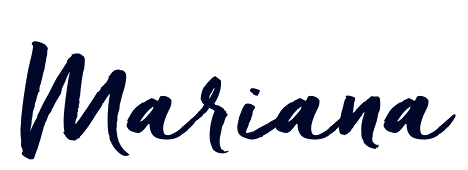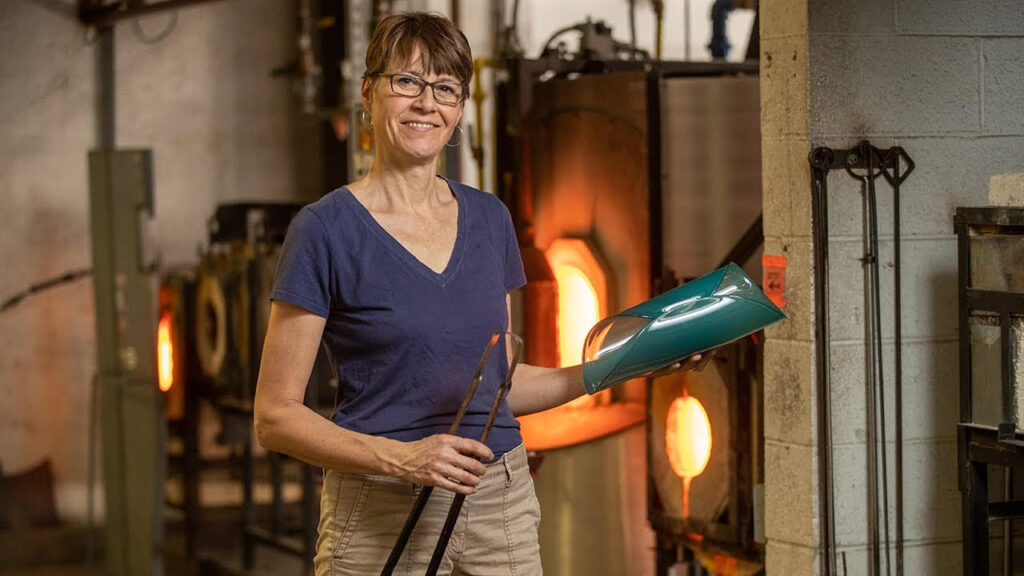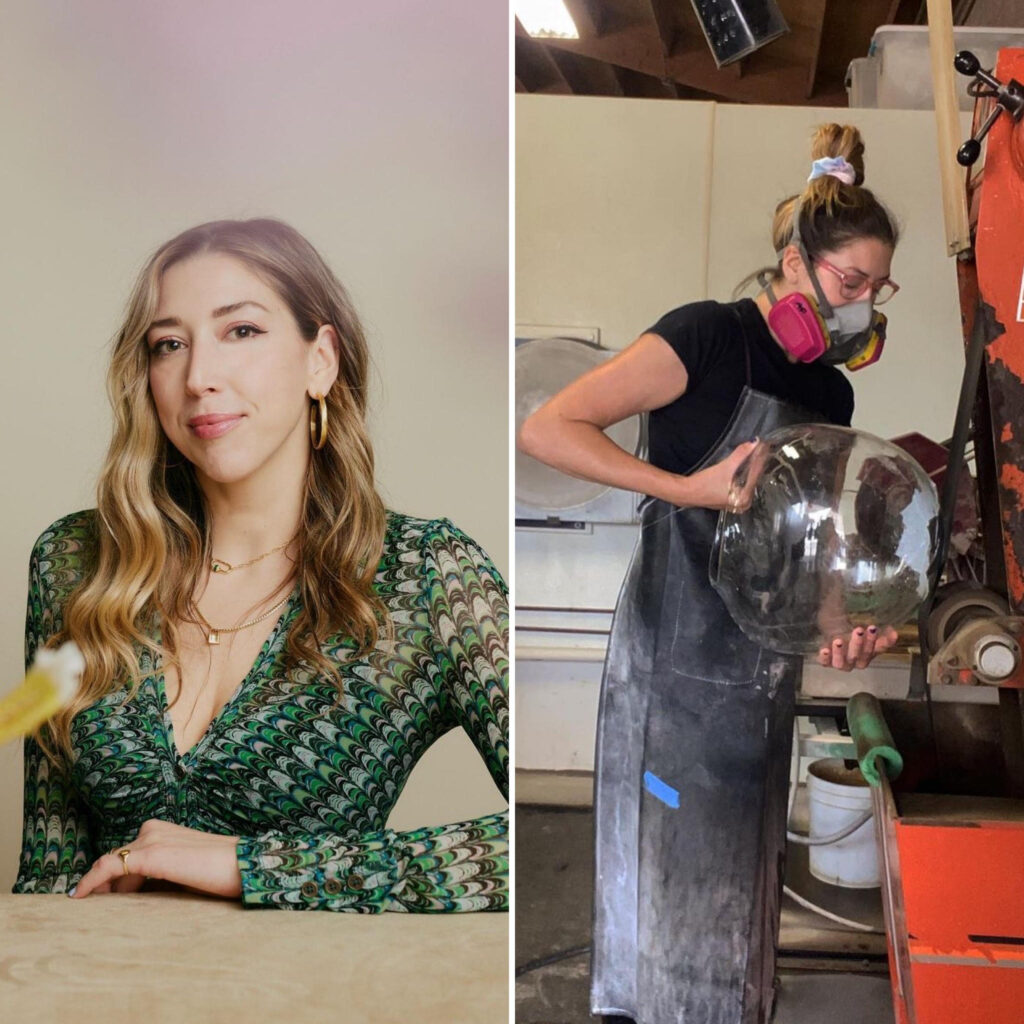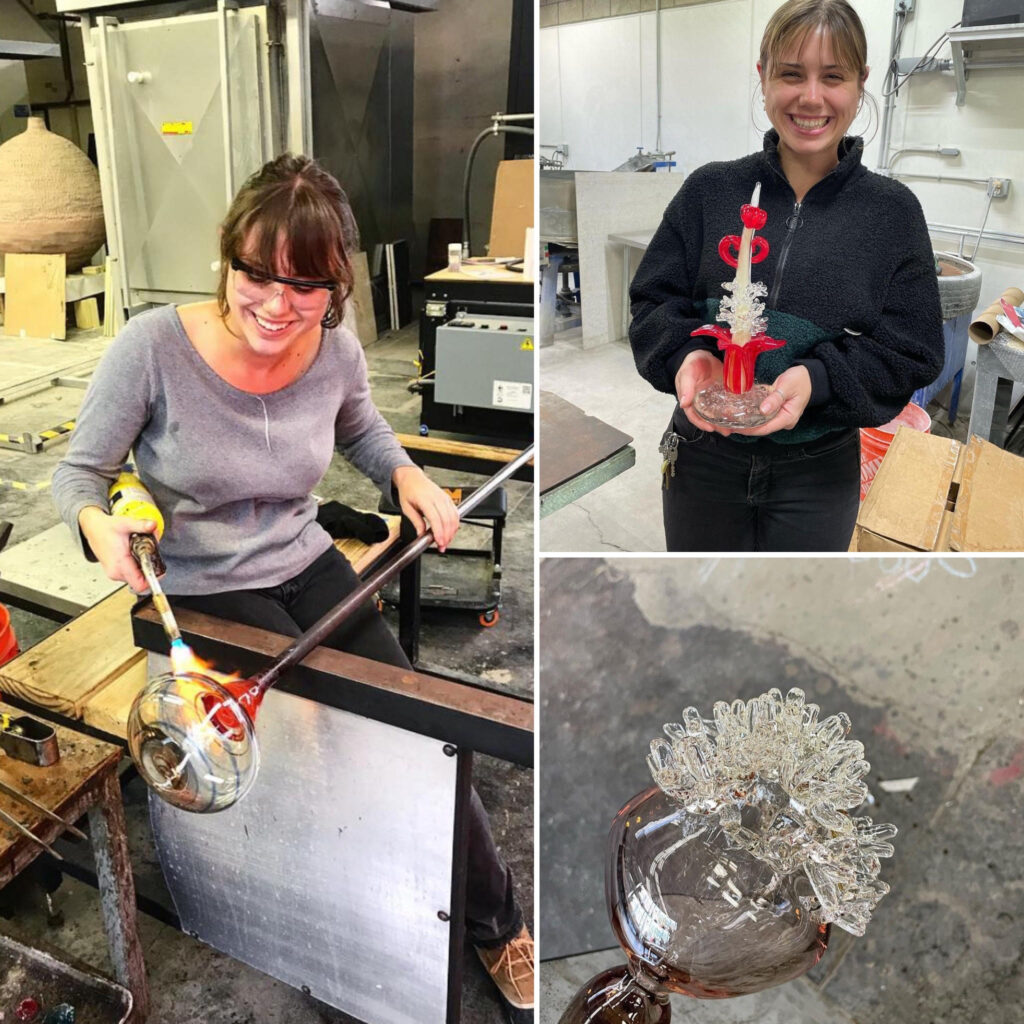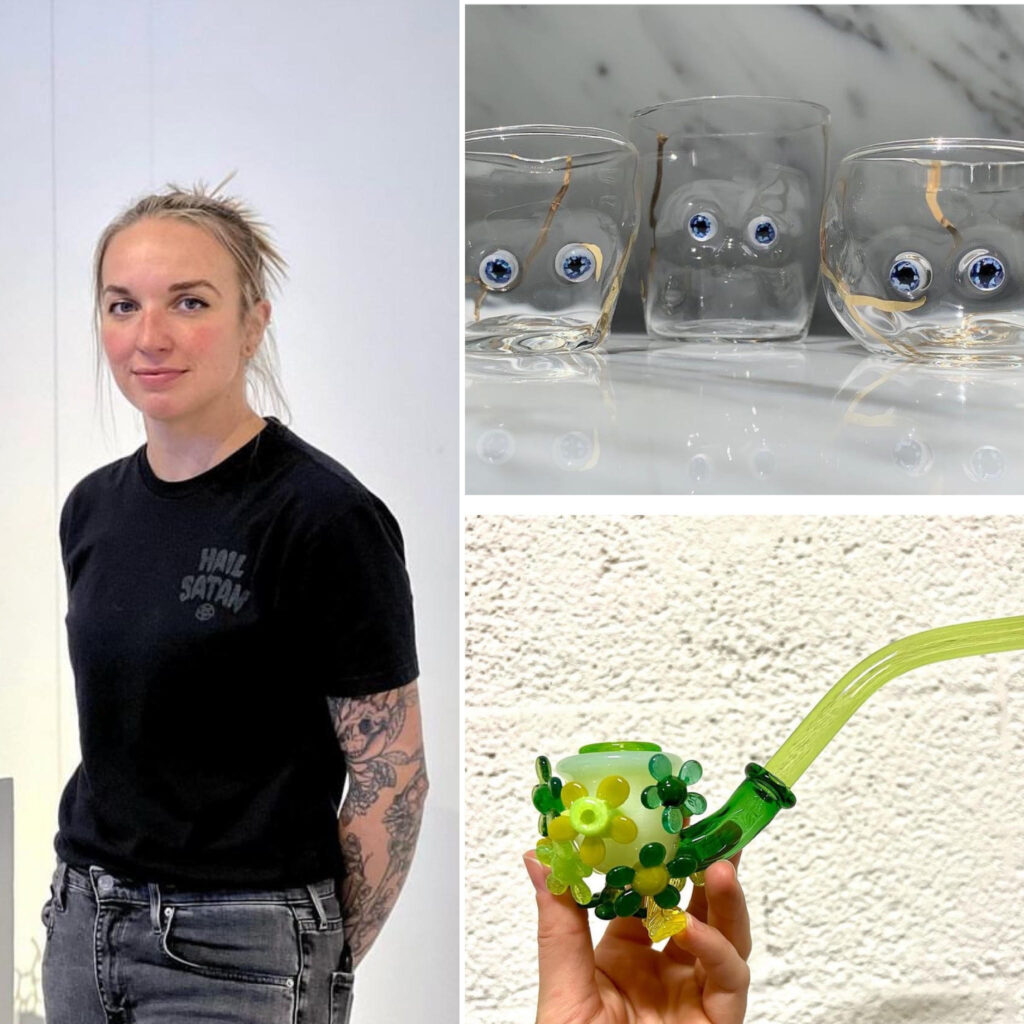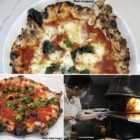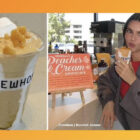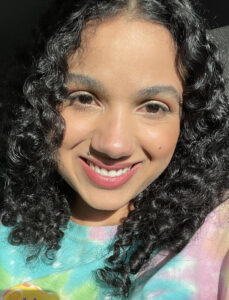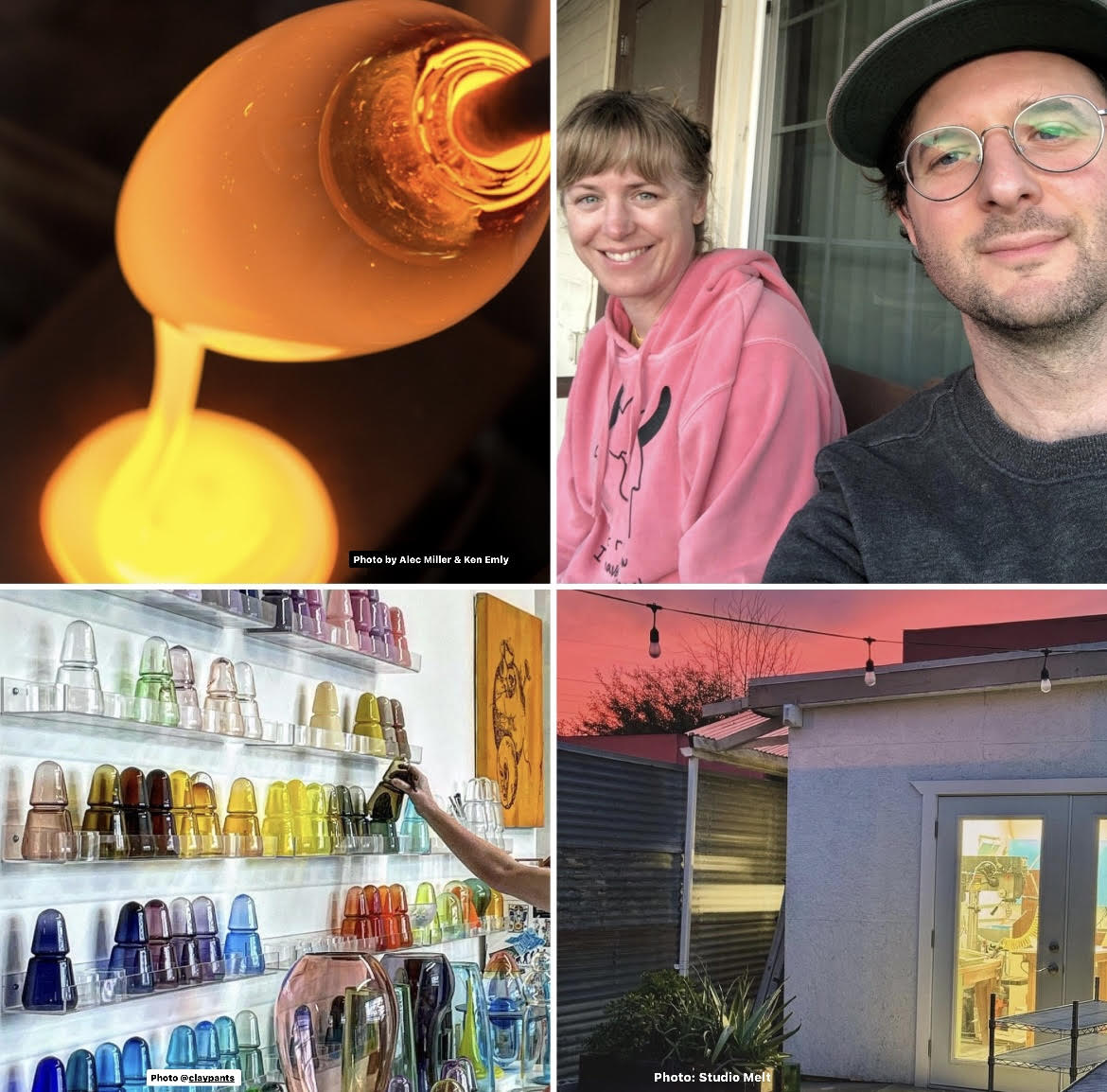
Glass is a material that’s ubiquitous in our lives: the windows in our houses, apartments, cars, cellphone screens, a glass of water in the morning… Have you ever stopped and wondered how it’s made?
There are several different types of glass and techniques. In this post, we’ll be talking about glassblowing.
Glassblowing dates back to the first century B.C, and it has always been a very insular job. However, in the last few years, there’s been a growing interest from the general public in learning more about this ancient craft. A great example is the glassblowing competition show on Netflix, Blown Away (2019).
Social media has also been a huge advantage for the glassblowing community. Besides promoting their studios and products, glassblowers can now share with the world the mesmerizing process of making glass.
On Youtube Shorts, which has the same format as Tik Tok, EricBlowsGlass, a glassblower in North Carolina, posted a video making a Swedish bowl. The video, which has garnered a whopping 171 million views, shows Eric *gathering glass from the furnace, and then twisting it, cutting it and shaping it. His following on Instagram is very small compared to the +700K subscribers he’s amassed on Youtube, which goes to show that video is the best format for glassblowing content.
*Gathering in glassblowing means taking molten glass from the furnace on a blowing iron.
Even though glassblowing has grown in popularity, it’s still relatively unknown to the general public. When I told people about it before this post went live, a few had a vague idea of what it was, others didn’t know anything about it. This is where Studio Melt comes into play.
Studio Melt is a glass studio owned by husband-and-wife team Ethan and Amanda Stern, two veteran glass artists. They first met in passing in 2009 at Pilchuck Glass School, a glassblowing school outside of Seattle. Ethan and Amanda had worked as staff members in their summer programs for many years. After reconnecting in 2012, they got married a few years later and continued to live and work in Seattle.
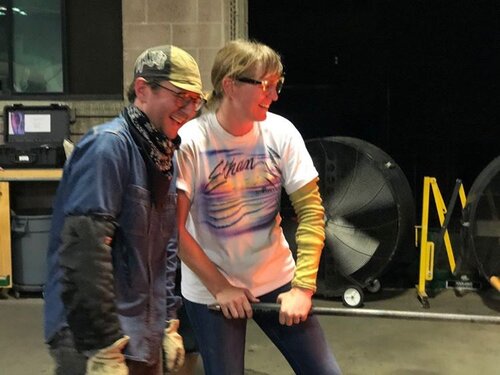
At the beginning of 2019, Amanda and Ethan moved to Los Angeles. They lived in Echo Park and worked at their studio in West Adams (Mid-City area). Last year, Amanda and Ethan moved to Frogtown (Elysian Valley), where they converted their garage into a glass studio/ home office.


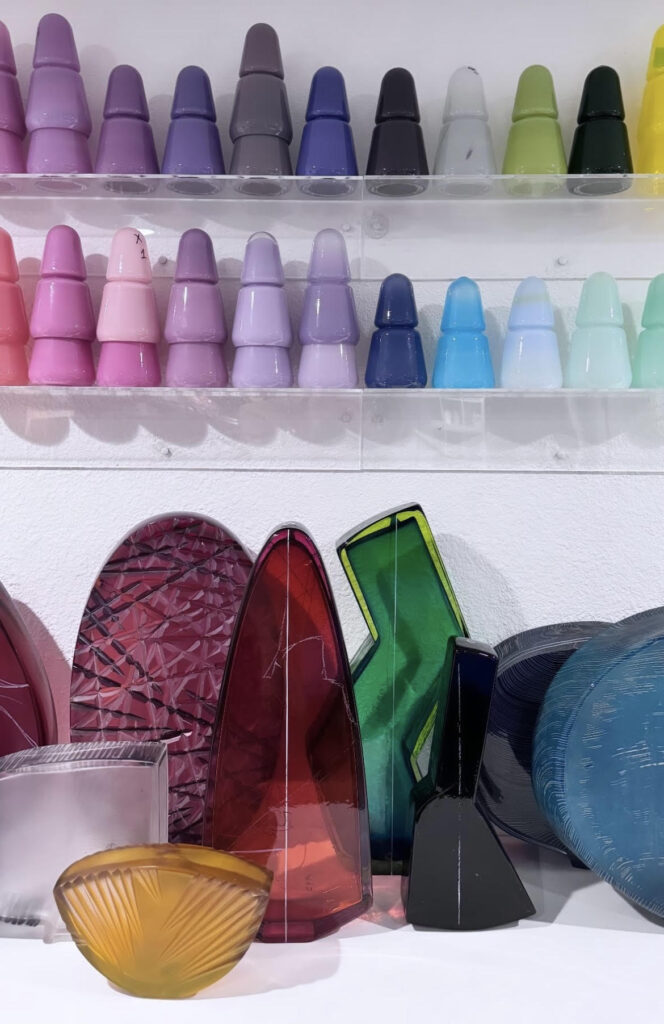
By opening Studio Melt to the public, Amanda and Ethan want to educate people on glassblowing. The studio has only been open since February, but they hope to do events and glassblowing lessons in the near future.
I went to the Frogtown Flea Crawl on a gorgeous Sunday afternoon. Before I reached the bike trail, I came across a sign that read “Studio Melt”. After walking into the studio and falling in love with their beautiful glass creations, I went back the following week to interview them.
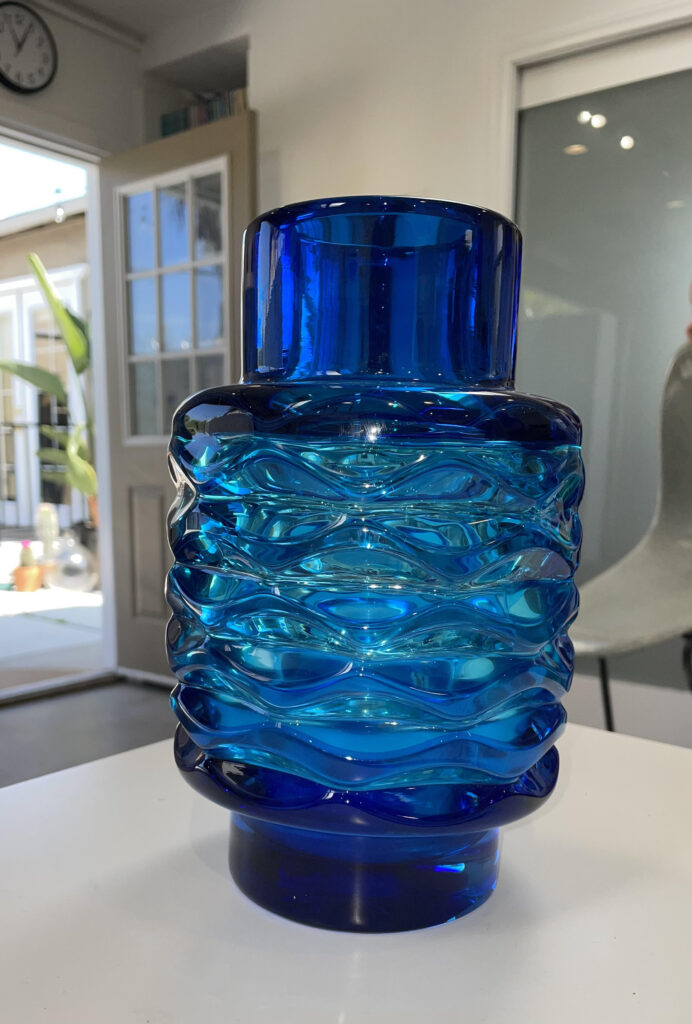
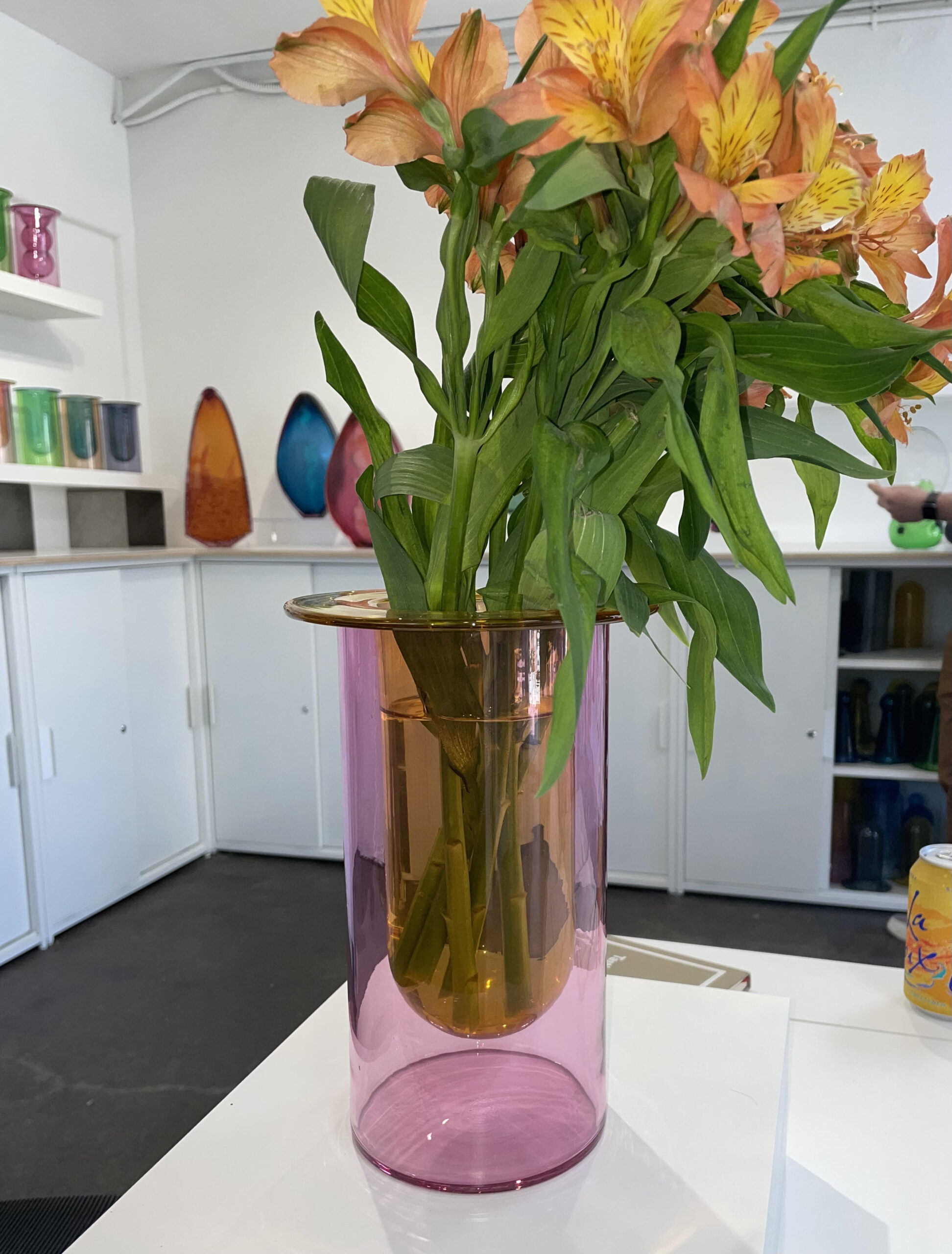
During our interview, Amanda and Ethan shared their journey as glassblowers, their inspirations, and how living in Los Angeles has helped them take a different approach to their work.
If you’re thinking of visiting Studio Melt, you can DM them or watch their stories for their next showing! They usually open the studio on the weekends.
I hope this interview inspires you to learn more about this fascinating craft, and maybe, sign up for a glassblowing lesson! Enjoy. ❤️
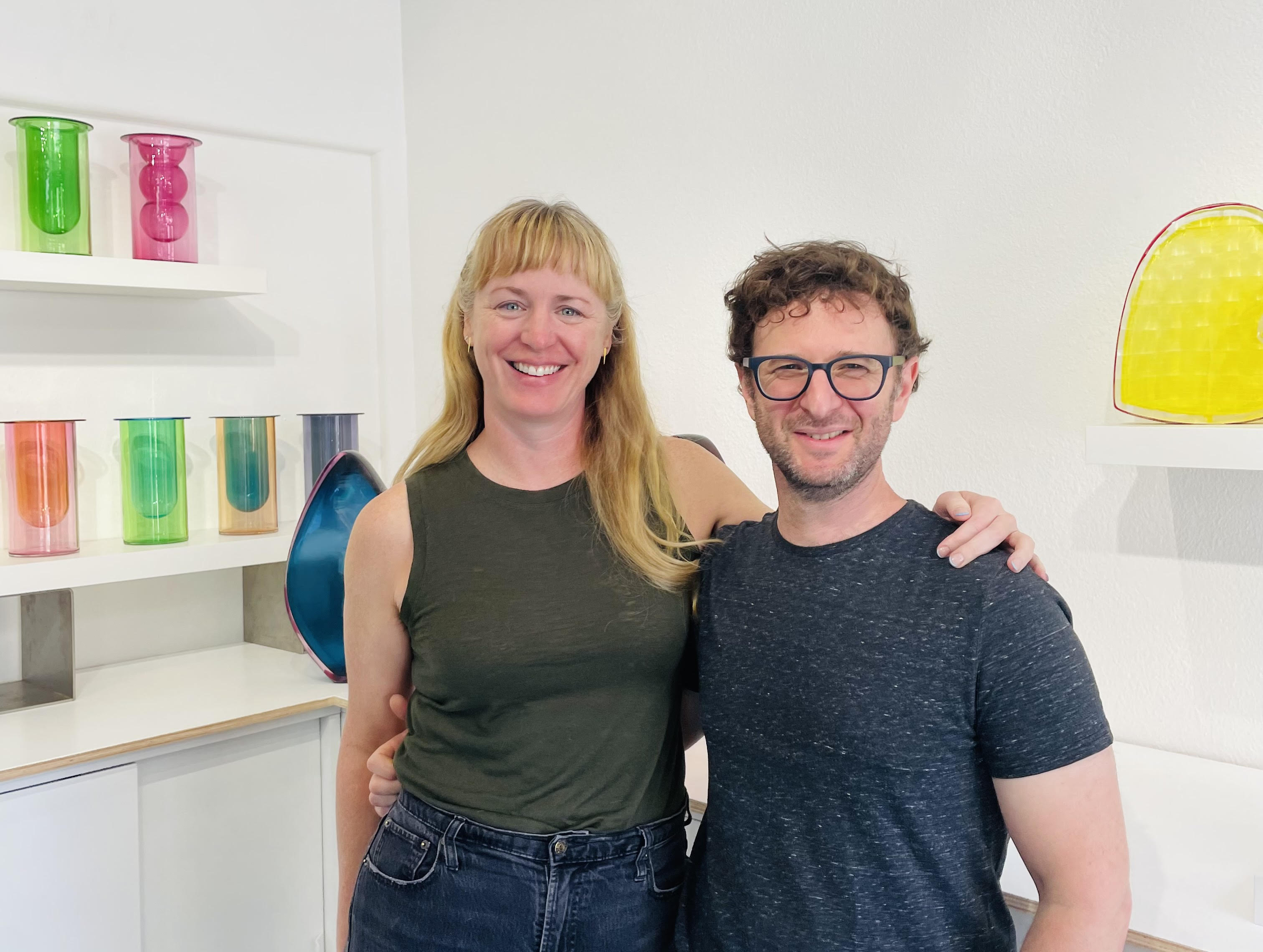
Amanda and Ethan, thanks for doing this! Why did you decide to open Studio Melt?
Amanda: We moved here last year. The space was beautiful and we thought about opening it to the public. We’ve always had our private studios where we did a few occasional events. But we love glass, and we met blowing glass. We thought opening the studio to the community was a nice way to share that with everyone. How is it going to develop? We’re still figuring it out! This is so new to us.
Ethan: There’s also a lot of mystery surrounding the process of making glass. Glass is something we’ve spent so much of our life doing, and we wanted to take that opportunity to share that. We teach in different places and may also teach here.
You both have had many years of experience with glassblowing. What is the best part about it?
Amanda: Wow! There are so many things! There’s a difference between the process of glassblowing and glass as the finished material.
The process of glassblowing is really challenging, but at the same time a very poetic process in the rhythm and the pace. When I was younger, it was a challenge because there’s so much to learn. It’s material you cannot physically touch because it’s over 2000 °F. You want to get closer to it, but you can’t. There’s also this level of complexity of science and physics. To work well with it, you have to understand the material first. That was so fascinating to me.
As a finished material, I don’t think there’s anything comparable in color and the way it plays with light. It’s mesmerizing.
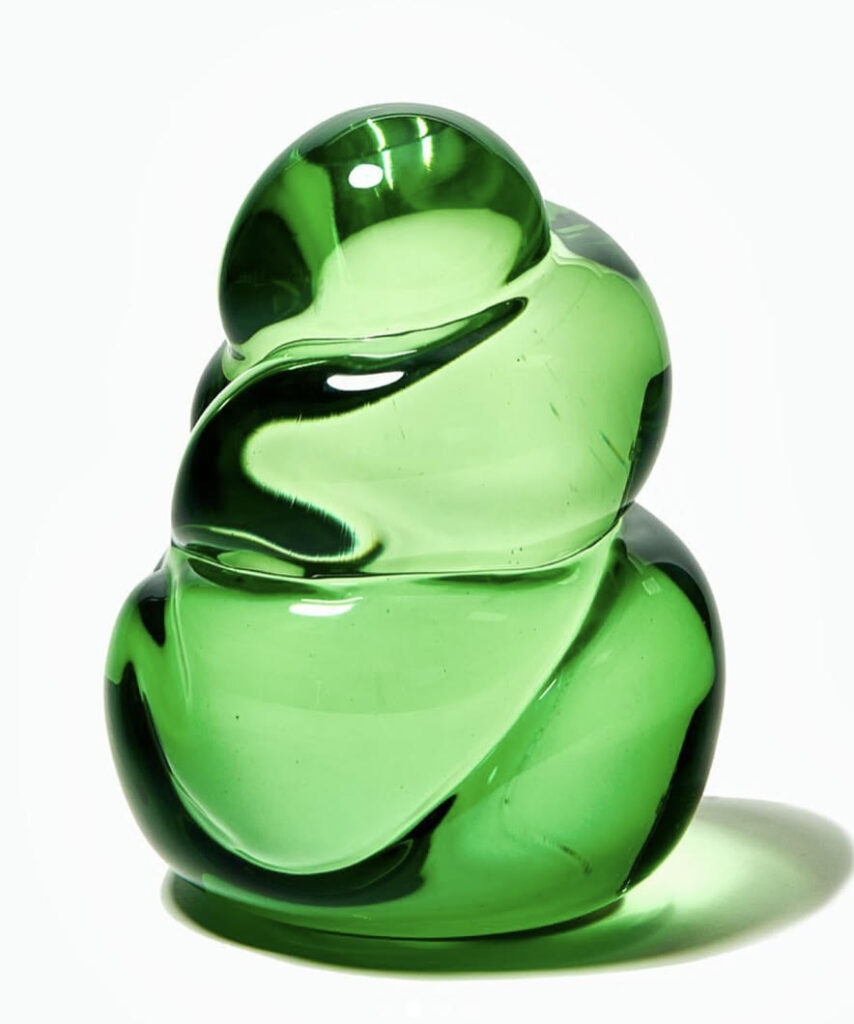
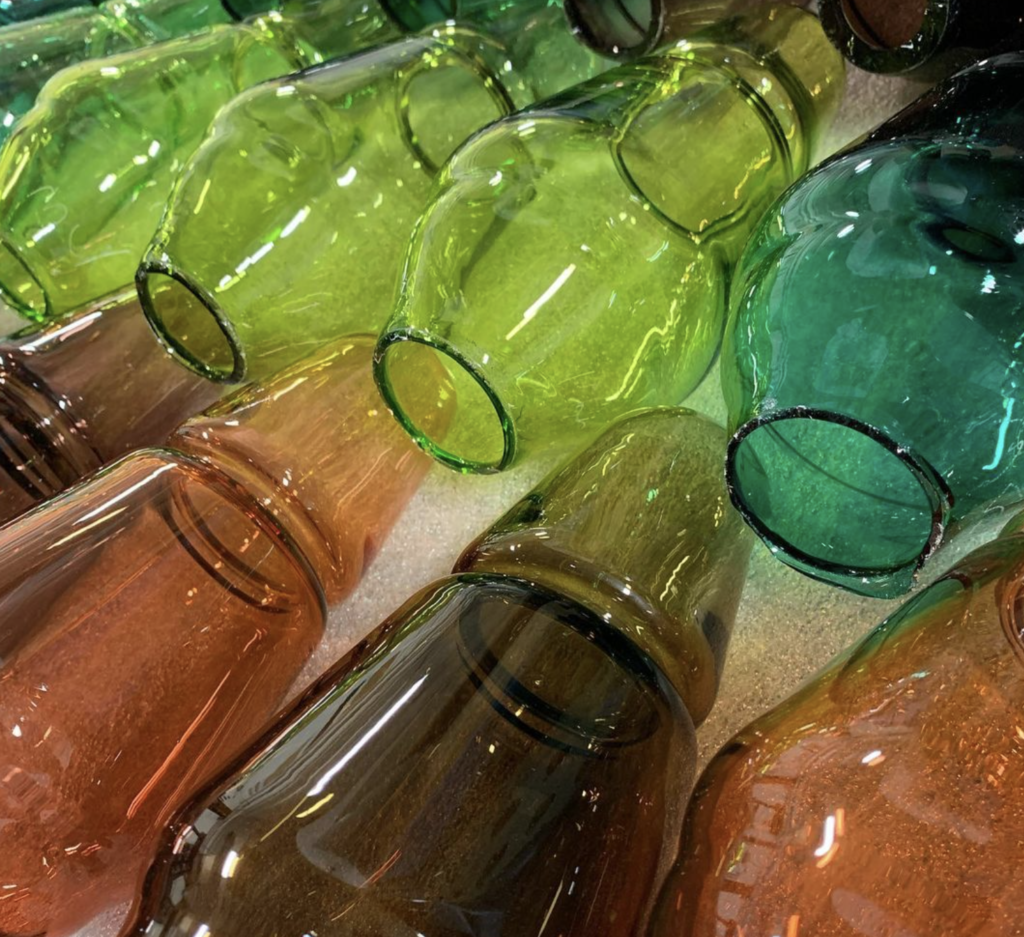
Photos by @studiomelt_la
Ethan: I came from a background in ceramics. That’s a really solo mission, but I was drawn to glass because of the energy in the process and the teamwork involved. There was more momentum being in a studio that’s a lot louder and hotter. That, and being able to play with material in molten state was so intriguing. After the glass is hot and cools down, I carve it. That’s where I get to slow down and have that unique vision and spend time on my own sculpting it. I treat it as ceramic. Those are the aspects that I really like.
Do you remember your first time glassblowing?
Amanda: Yes! I couldn’t stop laughing. I worked at a gallery that did glassblowing, and I had been watching it for months. I was a painter and I still paint, but I was interested in stained glass. Molten glass is the beginning of all of it. When I took my first gather, I sat down with it. It was the tiniest amount of glass. I picked up a tool to touch it. It was sooo squishy. There’s nothing comparable, but I just started giggling.
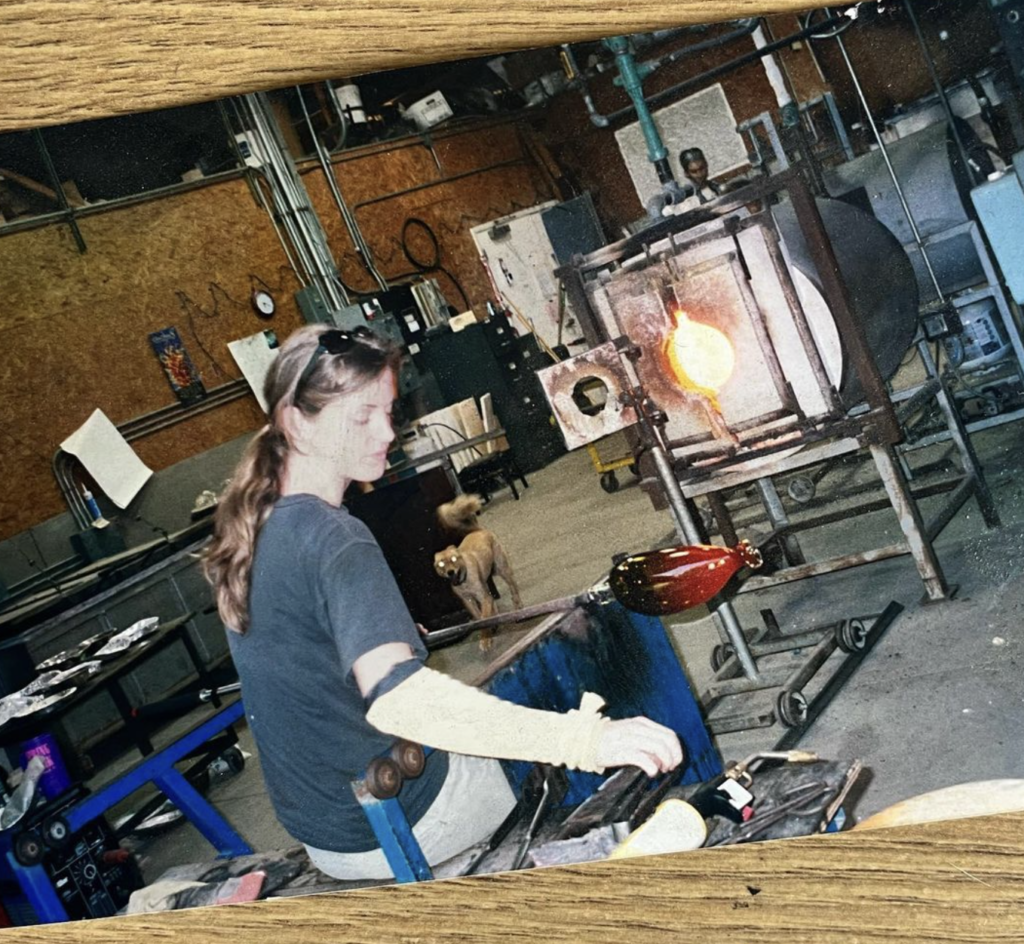
Ethan: Mine was in college. I was taking an elective glassblowing class. That feeling of taking that first gather, holding the pipe and trying to control the liquid with the bright light that it omits got me hooked. Even though the glass is crystal clear, it’s red and orange and it’s moving around. Another aspect that got me interested was the color. Coming from the ceramic world, a lot of the colors are very earth-toned, which I love. But glass has these craaazy popping blues, greens, reds and oranges. That color is so vibrant and attainable and the way the light moves through the material… I was hooked right away.
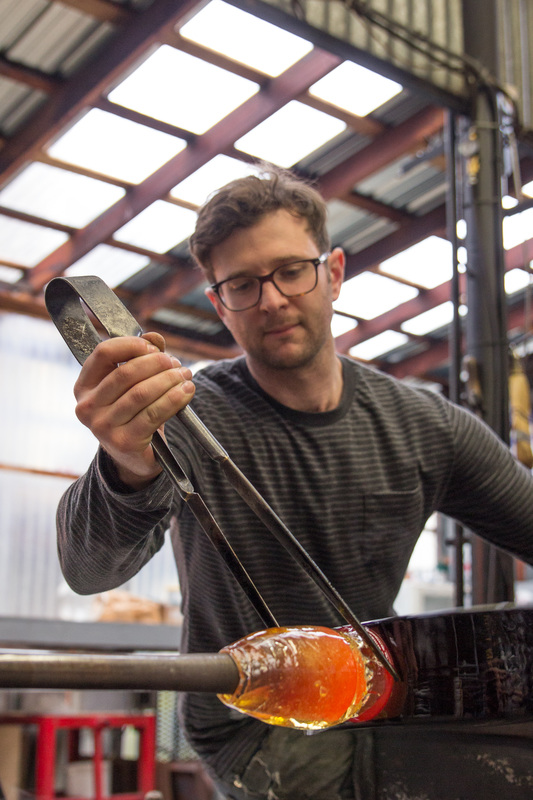
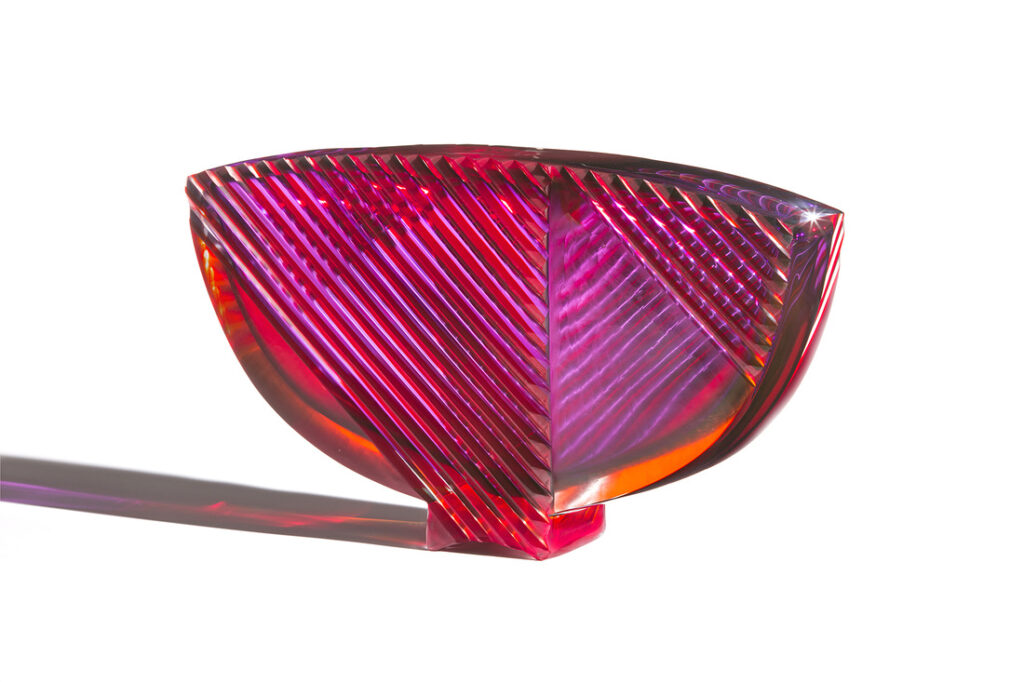
For someone who’s just finding out about glassblowing, what’s a simple way to describe the step-by-step process?
Amanda: There are several different processes. We primarily blow glass, which I’ll talk about later. There’s also glass casting and glass fusing, where people work with flat glass. You can cut the glass, layer it and then you melt it in a kiln. You don’t need a furnace and you don’t need to know how to blow glass. But that’s another process…
For blowing glass, you have a furnace with a pot inside that sits at 2000 °F, so it’s molten. It has the consistency of honey. Then, you have a blowpipe that’s hollow on the inside. You dip the blowpipe in the furnace and you turn it to pull out the molten glass on the other end. It’s like a pottery wheel but on the side because we’re working with it horizontally, instead of straight up and down. We can add more glass and keep dipping it in the furnace and blow through the blowpipe to make the form. Then, we have all kinds of various hand tools to manipulate the glass. We can cut it, twist it and pull it. That’s the simplest description (laughs).
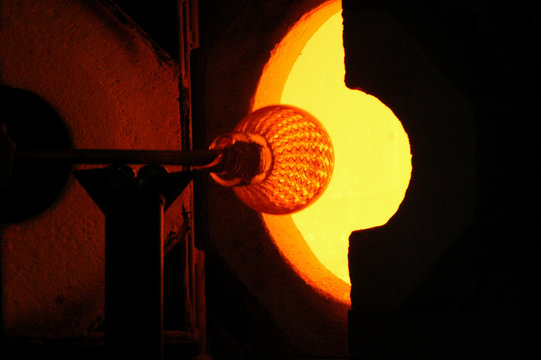
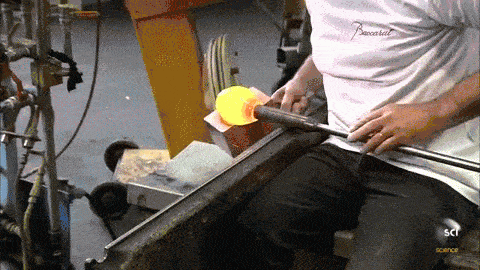
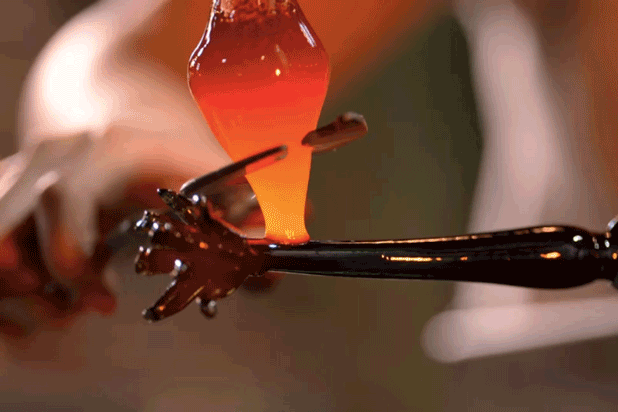
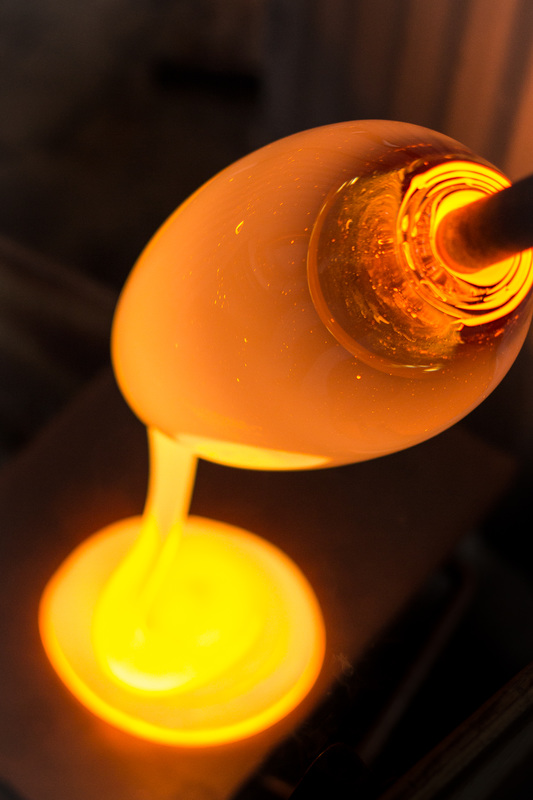
In the last few years, there’s been a growing interest from the general public in learning more about glassblowing, but it hasn’t always been that way. Why?
Ethan: Historically, glass has always been an industrial material produced in a factory, away from the view of the public. It’s also very expensive to make, so it hasn’t historically been approachable by the masses. When you look back at Italian glass from the Renaissance, the people who owned that stuff were royalty. Like the Venetian goblets, with the dragons? It’s not like you’d find that in everybody’s house. In our modern times, the studio glass movement is one way that glass has become accessible, like artwork. However, it goes all the way back to the 60s.
Harvey Littleton (1922-2013) is considered the father of the glass studio movement that started in Madison, Wisconsin in the mid-1960s. Ceramic professors got together and built a very small glass furnace with very little knowledge. It birthed this movement of making glass accessible to artists and students. Glass programs started popping up in universities around the country.
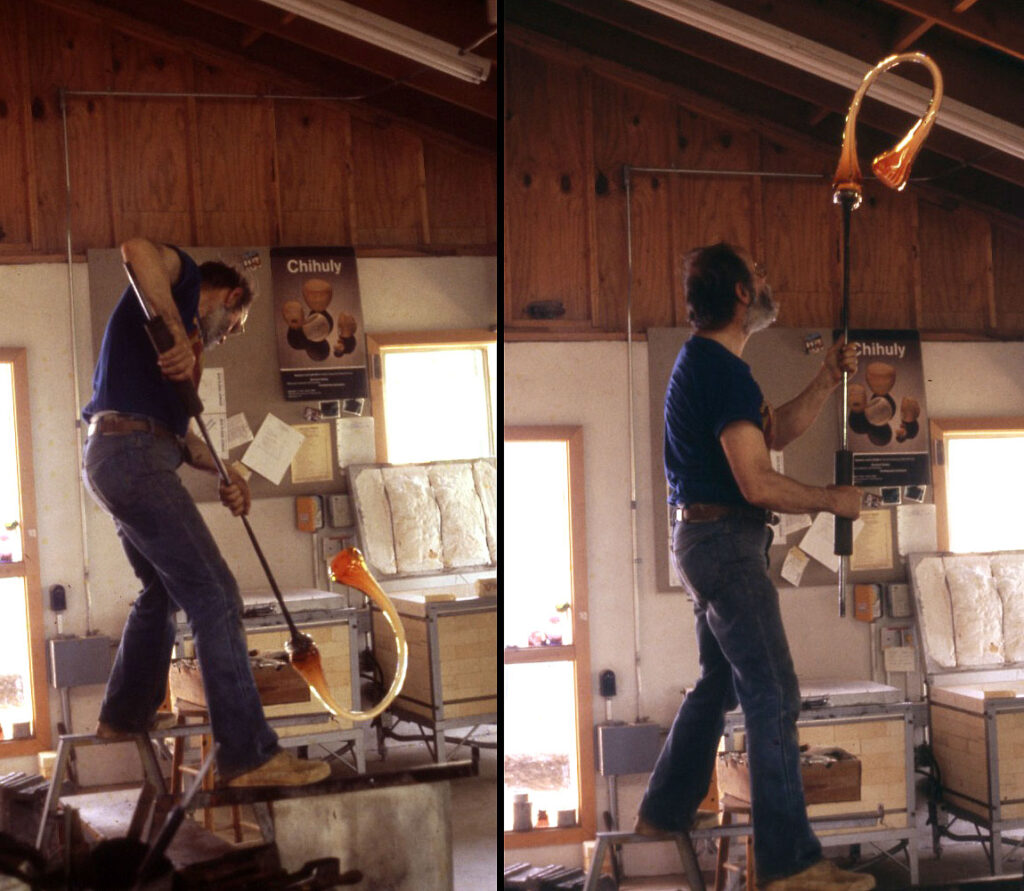

Pilchuck Glass School was founded in 1971. All these international glass artists and designers from factories throughout the world, like the Czech Republic or the Scandinavian region came to that school and taught their techniques. That accessibility started to spread.
Amanda: Glass is a very challenging material to work with, there’s a barrier to entry. For example, you can go out and buy a block of clay and start playing with it without knowing what you’re doing. You can’t just go out and buy a chunk of molten glass.
Also, typically in the factories, the furnace is running 24/7 and it’s built into the infrastructure. Making smaller equipment opened up a lot of doors for artists.
What does it take to become a glassblower?
Amanda: If you want to be the one physically making the glass, it comes down to time and learning the craft. You can begin by taking lessons. There are even university programs. Once you’re skilled enough, you can rent time in studios that are running their furnaces 24 hours a day.
If you’re trying to become very skilled, there’s no better way to learn than getting a job in production or manufacturing, where you blow glass 8 hours a day 4-5 days a week.
Ethan: One common misconception is that you need a certain level of physical strength. None of that is true. Even if you have a disability, anybody can blow glass, it’s a matter of making it accessible. It doesn’t hurt your lungs or anything. It’s like anything else, you learn the movements and your body starts to understand how to work with it. It’s about being able to think through the process.
Amanda: Also, the bigger the glass, the heavier it gets. Glassblowing is a team event. If you watch the videos, there’s always multiple people. When we start working big, our team can go up to six people. That aspect of glassblowing is one of the most beautiful parts. You have a team working together to help your vision. The person who’s leading the team is the gaffer, and we’re all helping each other. There’s this respect, understanding and community of wanting to help each other achieve their creative vision.
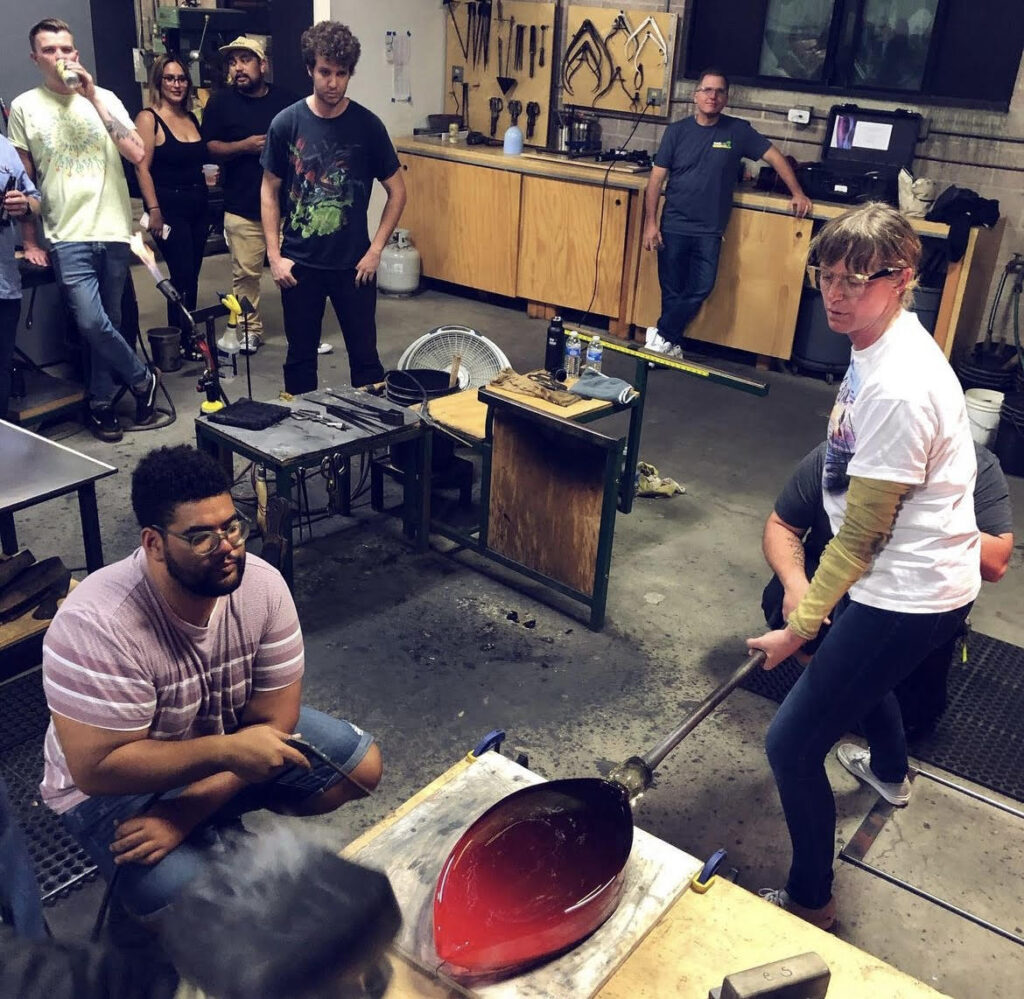
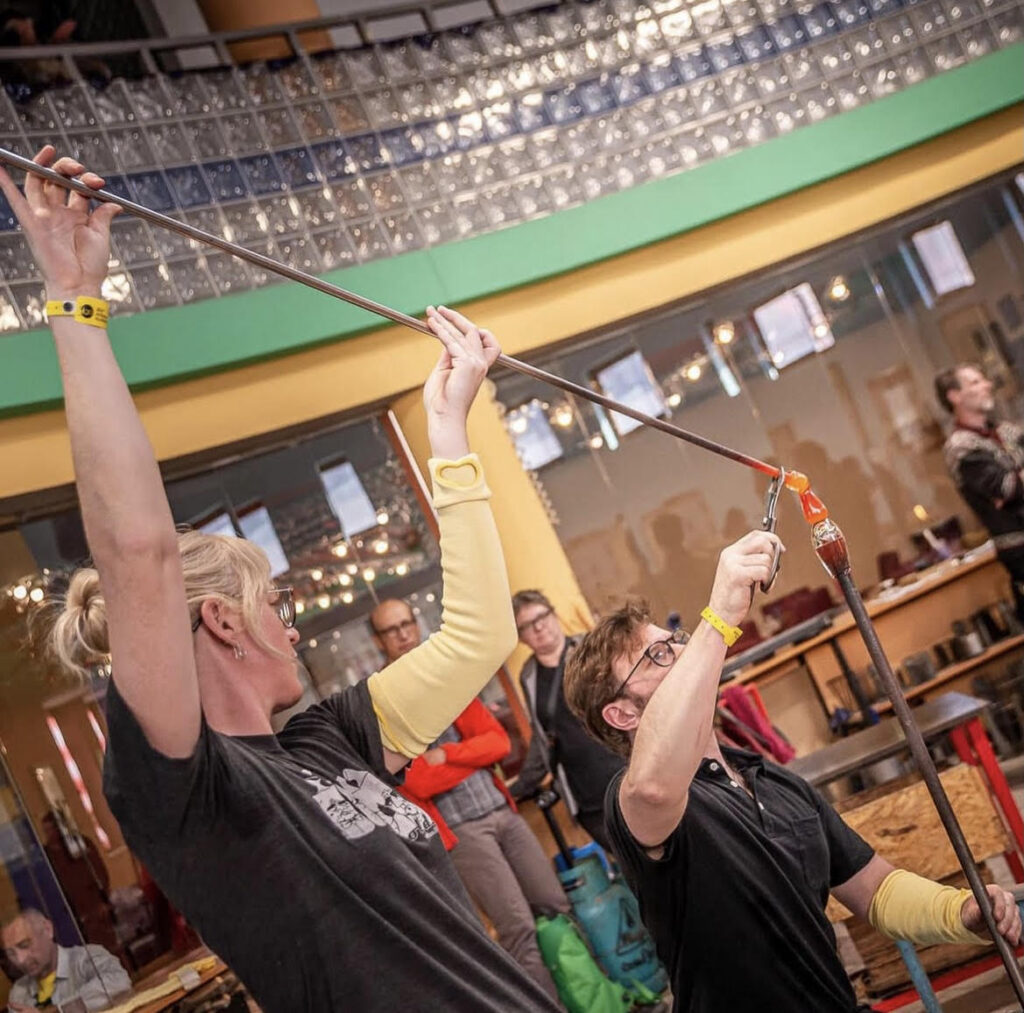
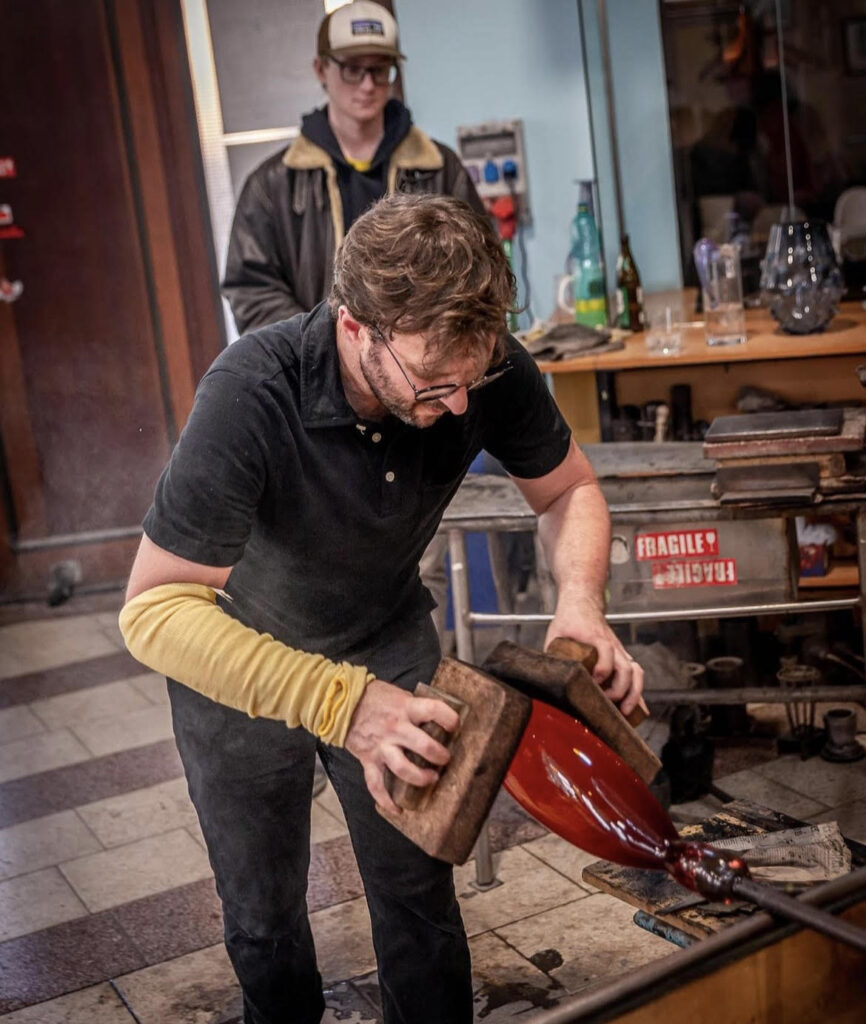
Is it dangerous at all? I read an article that talked about eye damage.
Ethan: That’s called the “glassblowers’ cataract”. Historically, that may have been a problem. But, it isn’t dangerous like that. You wear safety glasses, you tie your hair back, and you don’t wear things that are dangling down.
Amanda: I mean, if we’re going to talk about safety, it’s 2000 °F, so don’t touch it. Glass powder is the same as stone dust. It’s not good to breathe in, but you’re not working with it, that’s something that happens before you melt the glass or when you’re cutting it, like Ethan does. The furnace is very bright. If you’re sensitive by the bright light, you can wear specialty glasses. If you’re working in production and you’re doing it day in and day out, you may want to wear a darker shade of glasses. We blow glass typically twice a month, so it isn’t dangerous like that.
Why do you think it’s important to educate people on glassblowing?
Amanda: I think glassblowing can teach you so much beyond just the act of glassblowing. Even on an introductory level, it broadens your mind and drives you to ask a lot of questions. There’s so much inherent physics involved, so much teamwork, material science, why things are working the way they are… Experiencing glassblowing, even for four hours will make you start to think about so many different things.
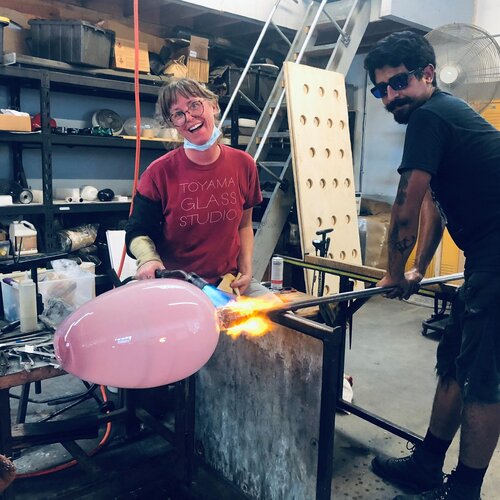
Ethan: I like the idea of how much science is involved. Accessibility is also really important. We want to be able to bring glass to more people. Historically, it hasn’t been that way. Glass is something that everybody uses all the time. From picking up the first glass of orange juice when you were a kid to looking out the window while you’re driving. That glass is a liquid material that plays a huge role in our lives.
Ethan, you were a glassblower in Seattle for almost 20 years. How does the glassblowing scene in Seattle compare to Los Angeles?
Ethan: The glassblowing scene in Seattle has evolved a lot. The Pilchuk Glass School has been a big part of the glass movement in the Pacific Northwest. As glass became more popular, a lot of artists started to move there in the 80s and 90s. I moved to Seattle in 2001 because at the time, it was the best place to have a career in glass. There were many small studios and a lot of opportunities. There’s also a big market there, and that credit should be given to Dale Chihuly, who is the most prominent glass artist in the United States. He helped create a market for glass in the 80s and 90s. Seattle was also going through this tech boom, so the economy was really strong.
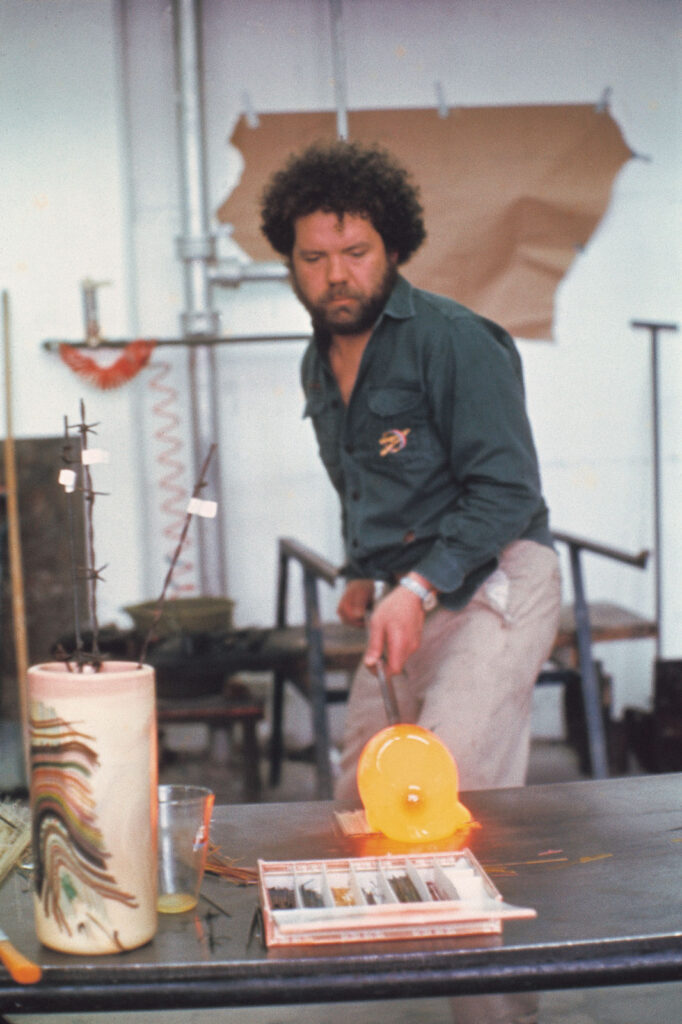
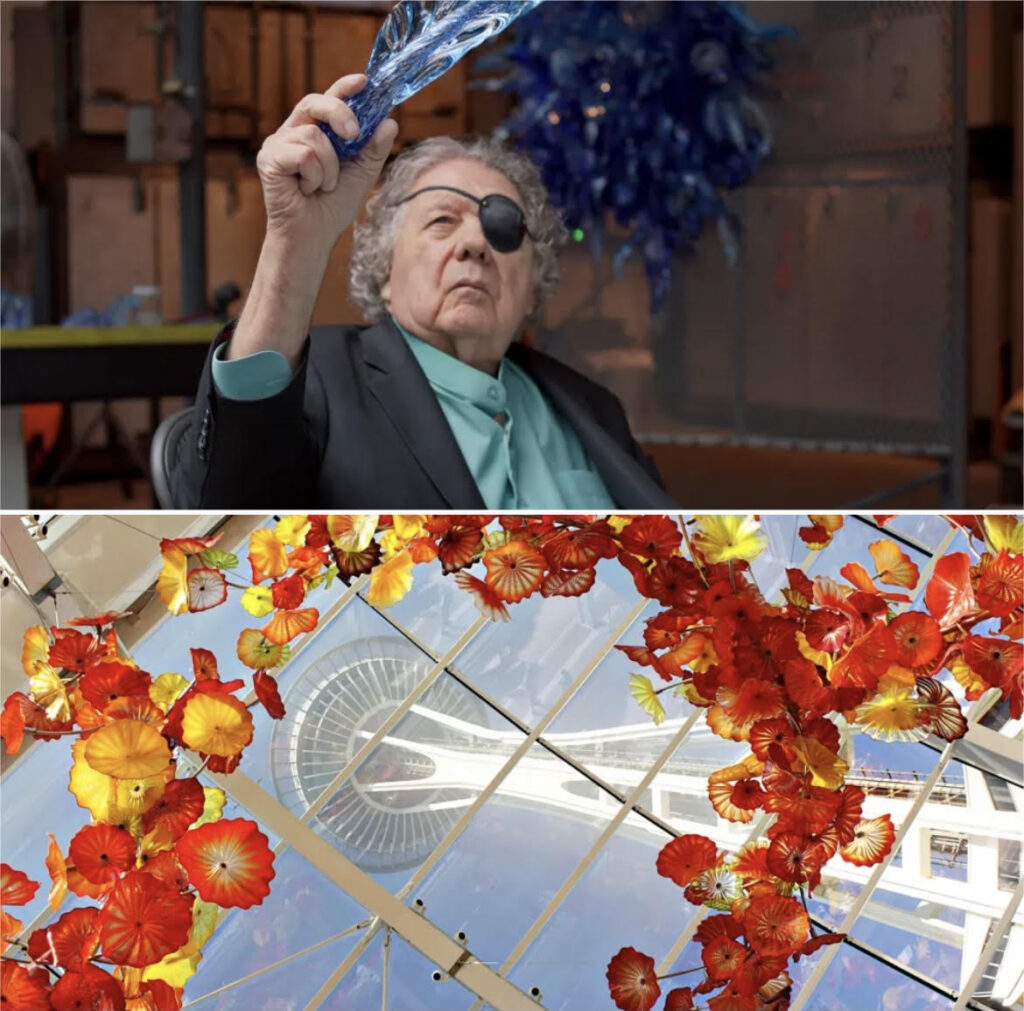
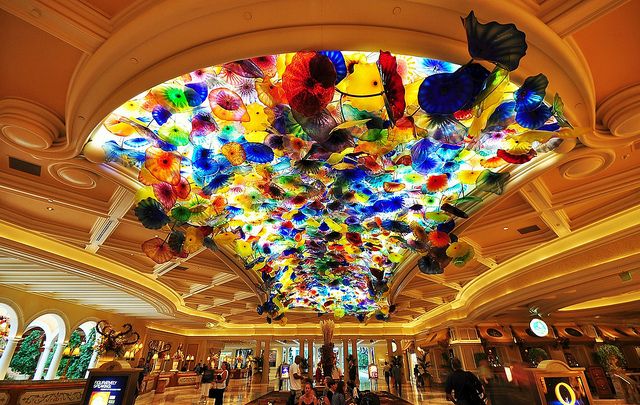
Before starting my studio, I worked in production and for independent artists.
In LA, there’s a similar community of artists and studios, but it’s smaller. However, because glassblowing is still a very new concept in Southern California, the ideas are fresh and people are very excited. There’s a great feeling and energy where people are starting to come together over this material. It’s a very exciting time for the glass community in Los Angeles. Not just LA, but also Orange County, San Diego, and even the Bay area.
If someone is thinking of visiting Seattle and doing a glassblowing tour, what are some must-visit places?
Ethan: There’s the Museum of Glass in Tacoma. It’s really cool, they have rotating exhibitions and a big studio where you can watch glassblowing. Chihuly Garden and Glass is a museum dedicated to Dale Chihuly’s work. There are incredible exhibitions and outdoor glass gardens.
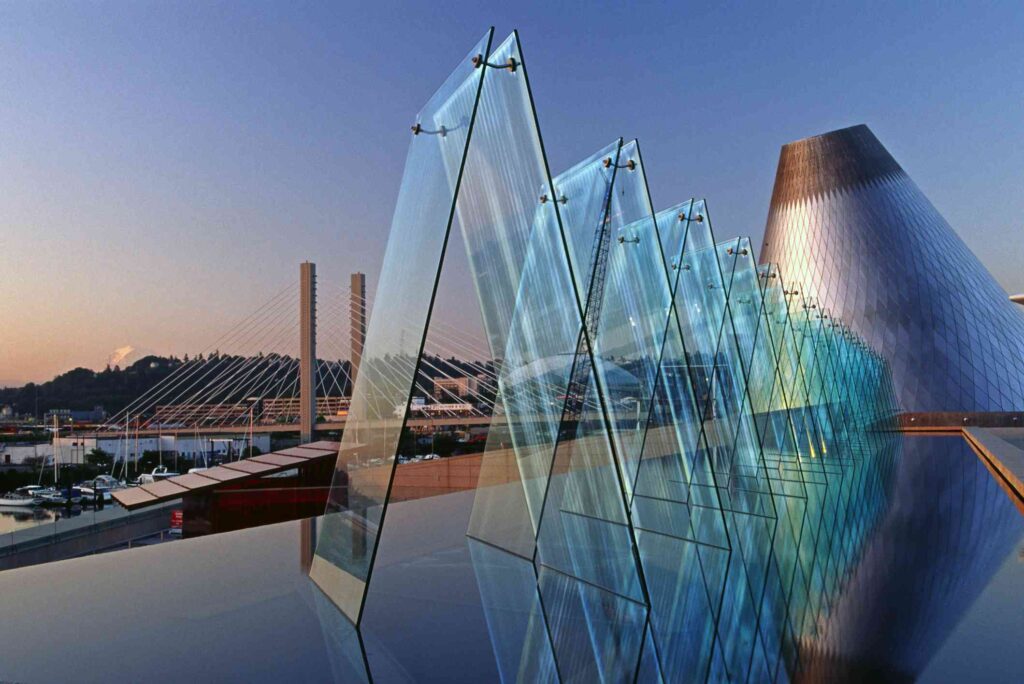
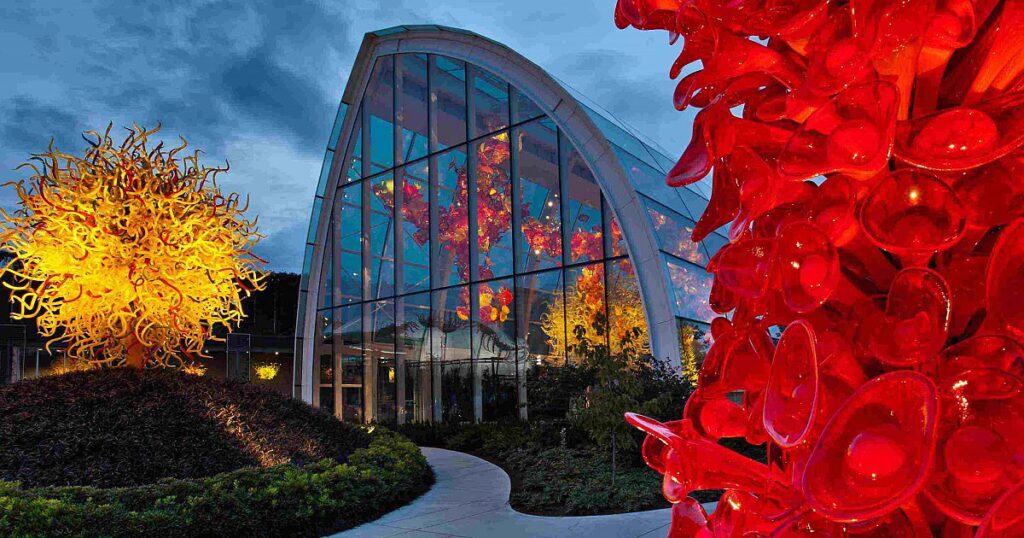
Amanda: The Traver Gallery. If you’re looking to explore glass and get a good sense of glass in the Pacific Northwest, those galleries are a great starting point. Also, Pilchuck Glass School, which is north of the city. They do tours of the campus and they also have an office Downtown.
Ethan: Pilchuck is about 60 miles north of Seattle and is located on a 15,000-acre tree farm. It’s a beautiful forest.
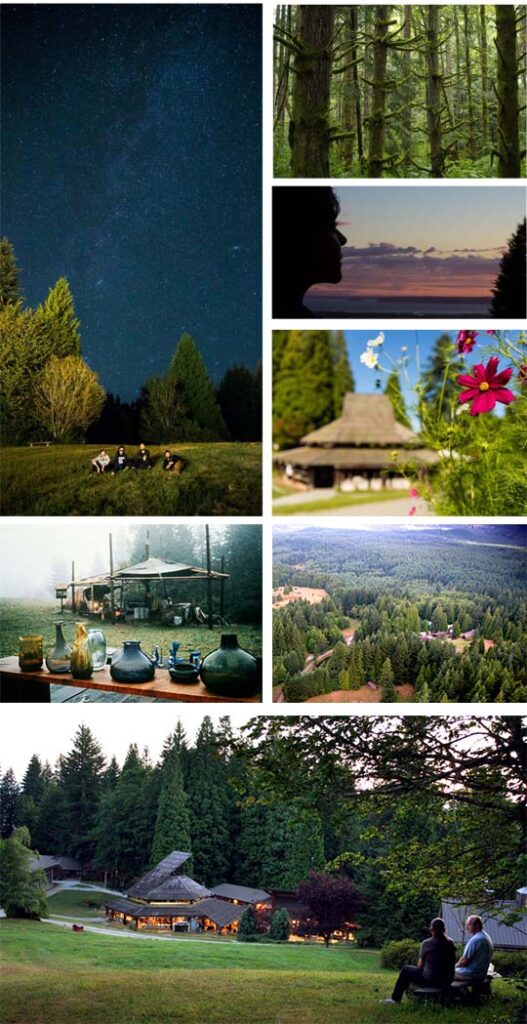
Where does your inspiration come from?
Amanda: Oh, boy. There’s so much! It’s life, experiences, colors…anything, really. Even the way the light comes out of the window one day. I’m very interested in the emotive property of line where two elements meet, like colors. How moving them closer or how overlapping them slightly can generate a completely different feeling towards the object.
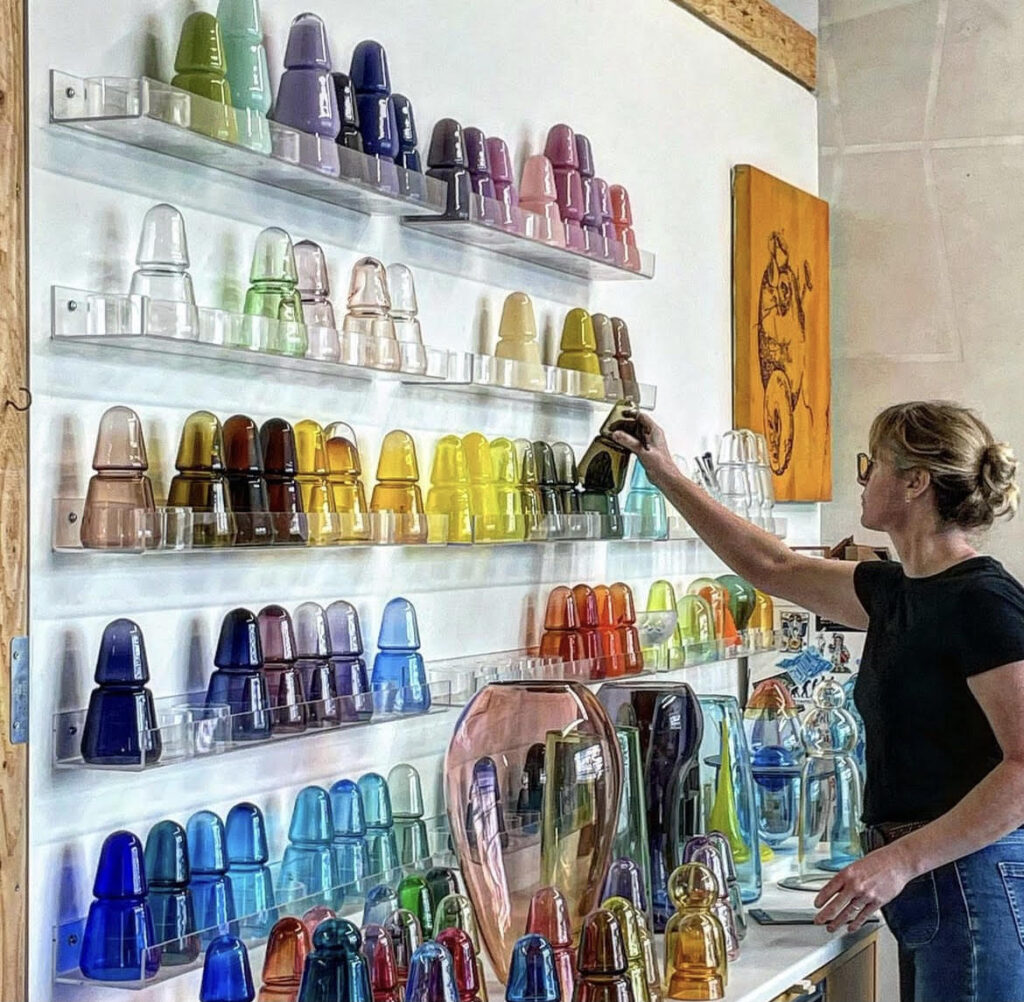
I relate that to relationships, very personal ones. Experiences in life, sociology, psychology… just how we relate and exist in this world. But from a design perspective, I think colors can also emit those emotions as well. Playing with that is the inspiration for me. Moving down to LA made a big difference because the light here is soooo different. It brought up a different perspective on light and color and the way that glass works as opposed to other places I’ve lived. It’s a roundabout answer, but there’s a lot of inspiration in nature and just going out and experiencing life, good and bad.
Ethan: I started as a ceramic artist and wanted to make functional ceramics. The ceramic vessel has always been a foundation point for me in the forms that I make and the objects I produce. The way that it’s sitting on the surface, its foot, its shoulder, and all this vocabulary that we use to describe a vessel. I think through the sculptural objects in that same vocabulary when I make glass. I make vessels now more than I used to. But, that element of design in making the glass object is a really strong part of the process for me, and LA has helped spur that. There’s such an emphasis on design here, and that has been a strong part of the creative world here in Los Angeles for a long time.
I also do a lot of carving and I’m very inspired by that process and how it relates to the environment, like geographic elements. Some of the series that I’m working on are inspired by the coastline geography. It’s that element of a rock formation standing on the top of a mountain and looking down. I like the abstract connection people can have with it in my objects.
What glassblowing artists and studios could you recommend here in LA?
Amanda: There are so many! Just starting with the women in the glassblowing community: Austin Fields, Emily Brasch, Nao Yamamoto. Katherine Gray is also incredible.
Ethan: Katherine Gray is like the influential glass artist in SoCal. She was the main judge on the glassblowing competition show Blown Away (2019), and she’s also a professor at Cal State San Bernardino.
Amanda: Hiromi Takizawa, Danielle Brensinger. There’s Joe Cariati, who has had his studio for a long time. He’s an incredible designer and glassblower.
Ethan: His studio is the LA Glass Center in El Segundo. They do events and classes there. Then, Kazuki Takizawa, owner of the KT Glassworks studio in Mid-City. Our old studio was in the same building. He’s an incredible artist. If someone wants to do a glassblowing lesson, that’s the most accessible place to do it. You can sign up on his website to do a 3-hour glassblowing lesson. The KT Glassworks studio is a really good community hub of glassblowers in LA.
Amanda: Cedric Mitchell is also an incredible glassblower and designer.
Ethan: Corey Pemberton, Adam Cohen…
Amanda: I know there are people we’re forgetting, but yes, the glassblowing community here is awesome.
Los Angeles
What do you like about living in LA?
Amanda: Oh My God. So many things, so many… We moved to LA in the beginning of 2019 for work because there’s a broader creative industry and more opportunities. We spent a lot of that year settling in because we weren’t familiar with LA. Once we fully settled in, the pandemic hit. Like, right when we started to explore, everything shut down. We’ve been venturing out more in the last couple of years.
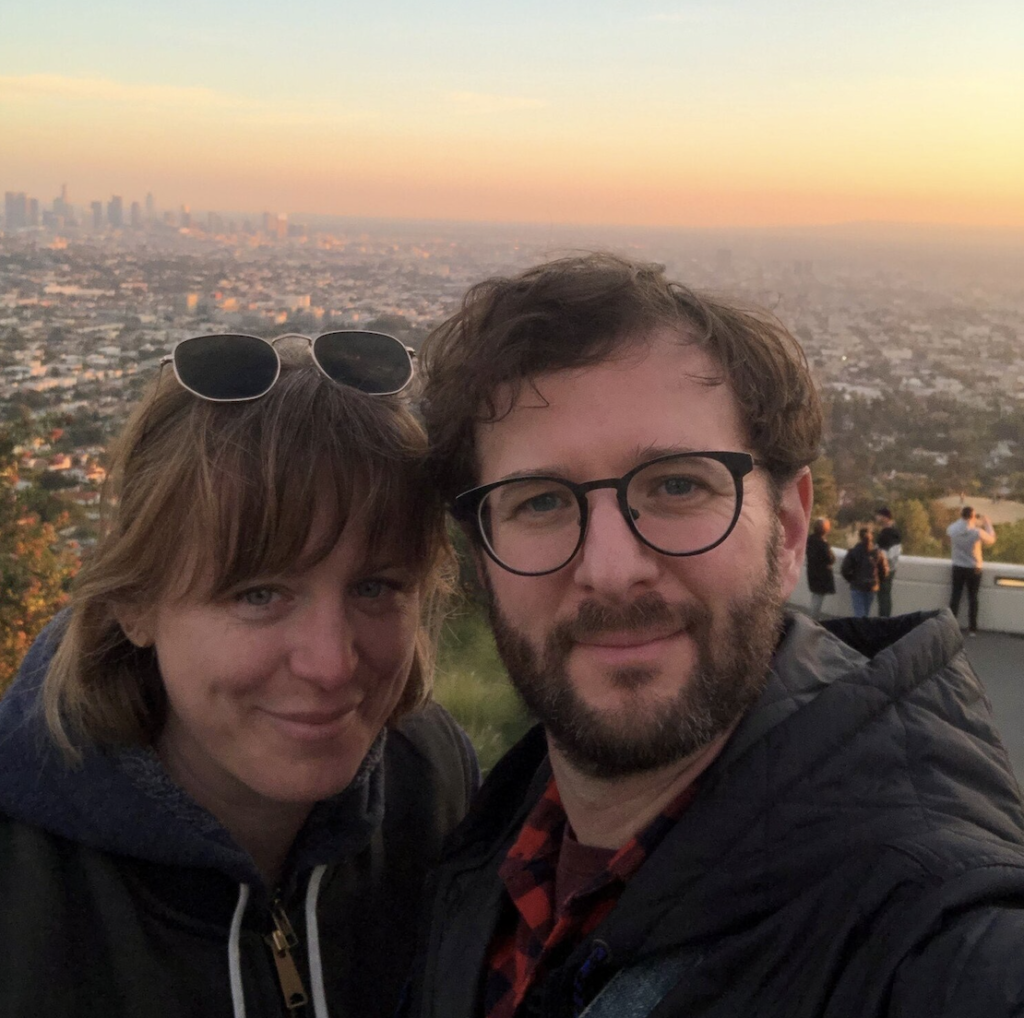
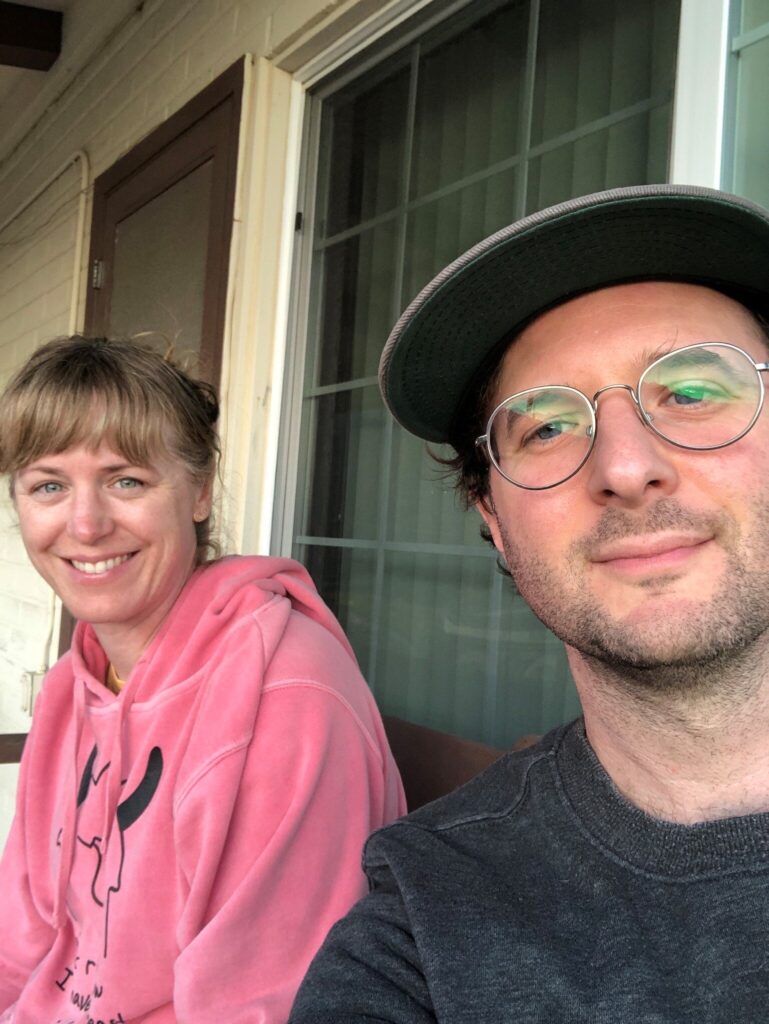
The food is incredible. The topography, the ocean, the mountains, the weather… People have been wonderful too. It feels like a very positive community in a lot of aspects.
Ethan: The amount of sunshine is amazing. I know there’s winter here too, but we get extra months of sunshine here. For someone who’s lived in Seattle for a long time, the weather really affects your mood, your mental health, and your artwork. If we look around this room, there are some dark grey objects and some really bright colorful ones, which sort of draws the line of comparison between Seattle and LA. I also love palm trees. I know it sounds very cliché, but palm trees make me smile.
Amanda: There are also flowers blooming most time of the year, that also makes me very happy. I love the colors. We also love the creative community here, it’s huge.
What are your favorite places and neighborhoods in LA?
Amanda and Ethan: We love Frogtown!
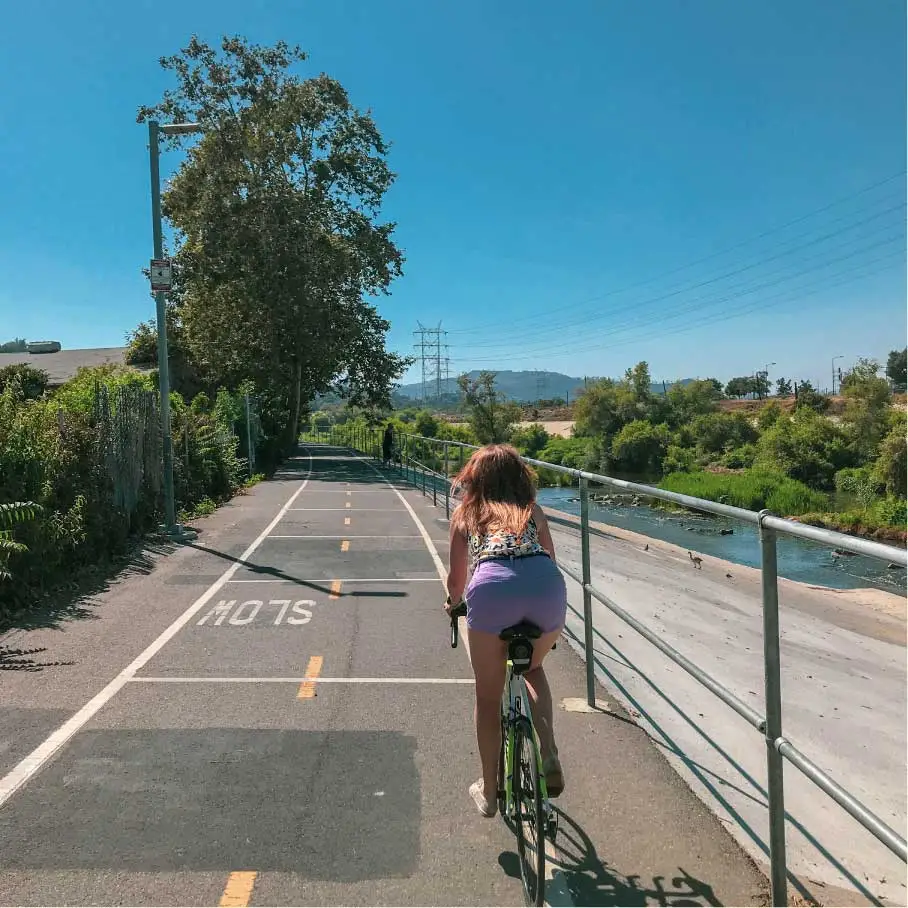
Ethan: Since we moved here, we’ve always lived on the East Side. We used to live in Echo Park, but we originally started coming here for the bike trail. Seattle is a very bike-friendly city and we rode our bikes everywhere. When we found the bike trail in Frogtown and saw the neighborhood, we were like “wow”. We always find ourselves on the fringe of commercial/industrial neighborhoods that have residential areas.
Amanda: As artists, that’s the best place to live. Frogtown has a nice mix of studios, smaller industrial buildings and residential homes. There’s also a feeling of being in a small town when you come here, but at the same time, you’re in this huge city. It’s so relaxing. It feels like you’re immersed in nature.

Ethan: The community in Frogtown is very close-knit. They’ve been here for a very long time and really care about their neighbors.
Amanda: Yes. In big cities, that community gets lost. Frogtown is also very walkable, quiet and peaceful. Even when there’s a lot of foot traffic, it still feels nice. Another place I like is the Santa Monica Mountains. One of my best friends worked for the National Parks and I got to experience the mountains through her. It’s so close to the city! Because we live on the East side, we forget there’s a beach here (laughs). So we don’t have a favorite spot…
Ethan: We like Zuma Beach, but we spend most of our time in the parks, like Griffith Park and the Elysian Park. We also jog around Silverlake.
What are your favorite restaurants in LA?
Ethan: Let me start by saying that we live next door to Loreto, which is an incredible restaurant. We’ve only been once and had an incredible meal. We held back on trying it for a while because once the floodgates opened, it could become dangerous. They have amazing ceviche and drinks. We love that place.
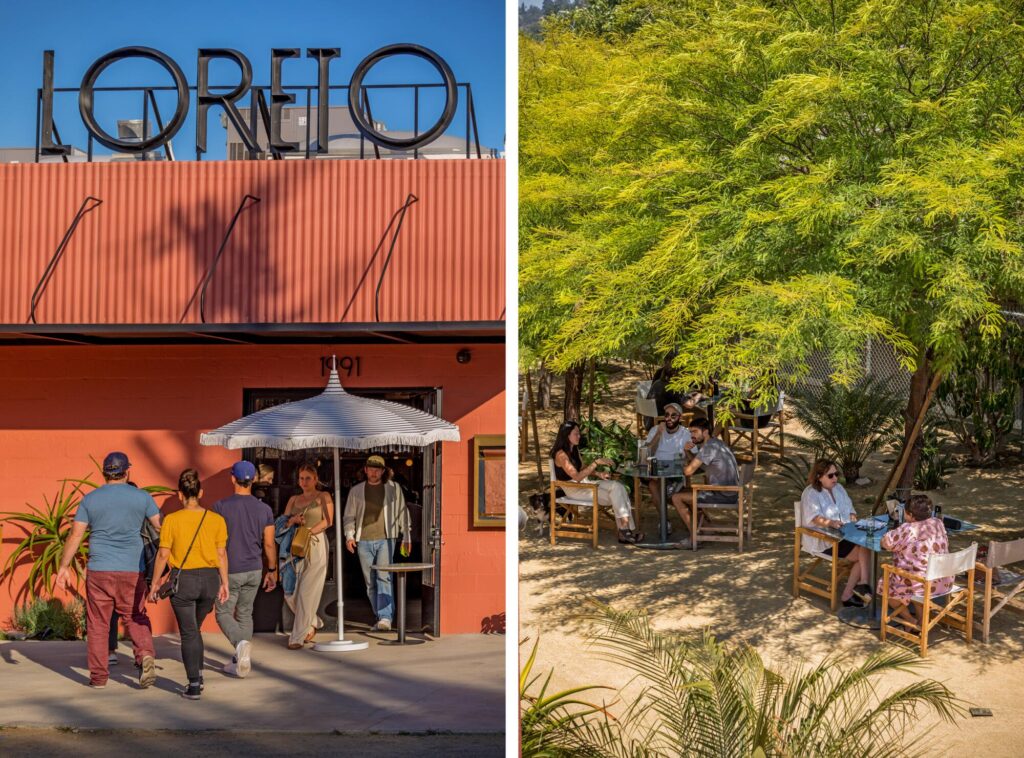
Justine’s Wine Bar is a new vegan wine bar inside Just What I Kneaded. There’s a mermaid door handle with no name on it.
Amanda: It’s incredible. It’s small and the atmosphere feels really good. The food is amazing.
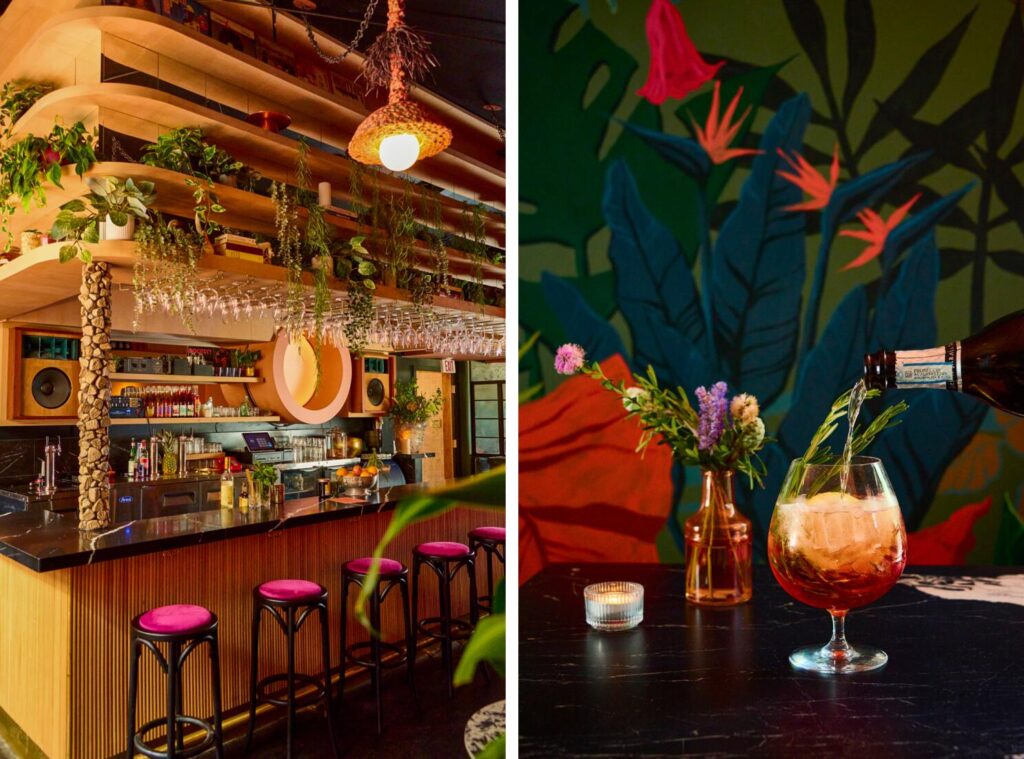
Ethan: All the Frogtown spots are amazing. We also go to Bowery Bungalow in Silverlake. It’s Mediterranean. It’s really really good. Oh My God, it’s incredible. Bulan Thai Vegetarian Kitchen in Silverlake is also really good. But here in Frogtown, we go to Wax Paper a lot, probably too much. (laughs).
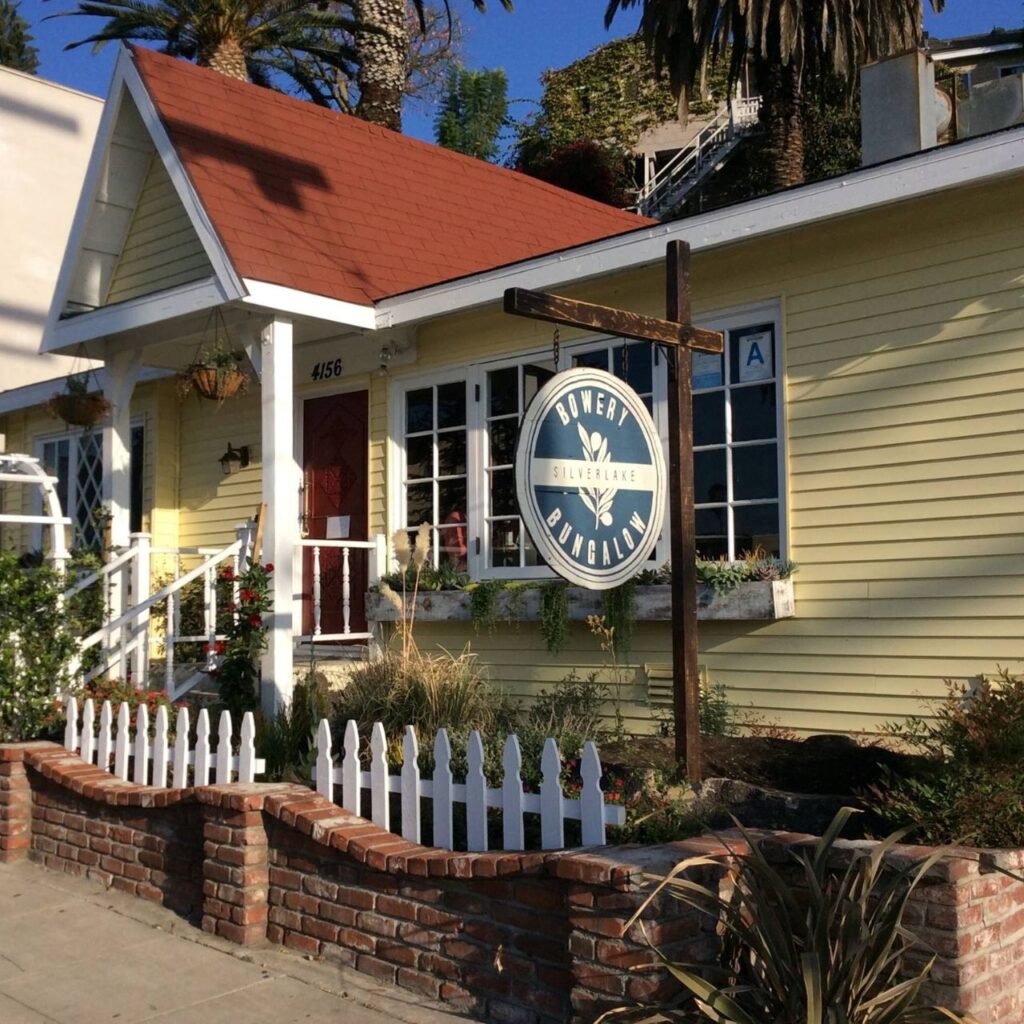
Amanda: That’s the thing! All the food in Frogtown is incredible. We could list them all. Spoke Bicycle Cafe has such a great environment, you’re outdoors and it’s really casual.
Ethan: We typically do our business meetings at Spoke! (laughs).
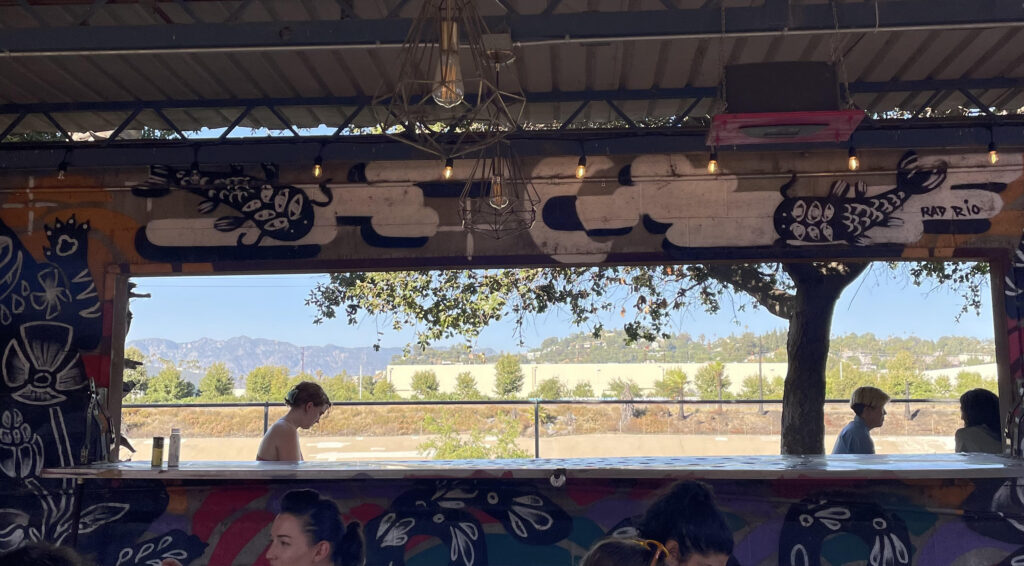
Have you been to Lingua Franca?
Ethan: Oh My God.
Amanda: Yes!! We were just talking about it yesterday. We had brunch there a couple weeks ago.
Ethan: I love the whole vibe of that place. We’ve even gone there when it’s super packed. We went there late at night a few weeks ago and got a table in the back. It’s a good mix of high-quality food and great atmosphere, while still being casual.
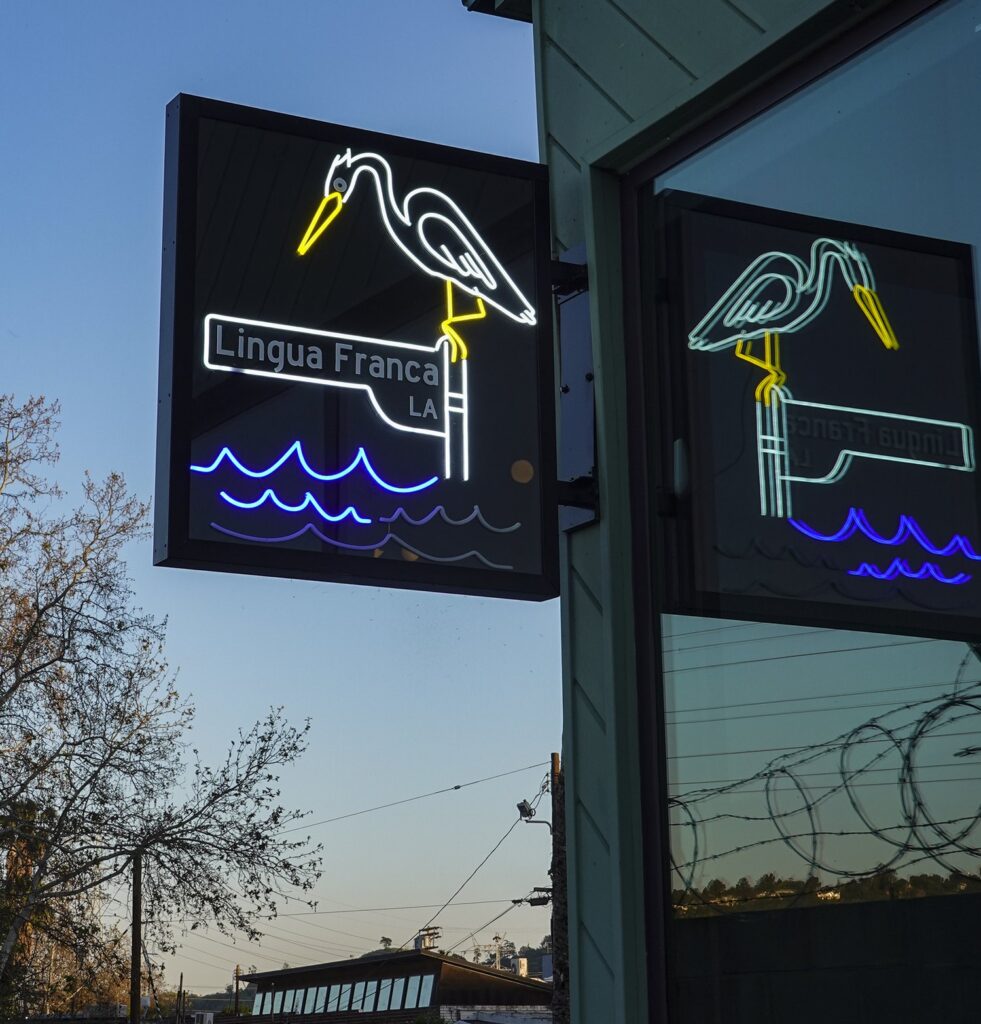
Amanda: We love Sage Vegan Bistro in Echo Park.
Ethan: It’s all vegan and they have incredible Buffalo wings. They also make their own beer. That place is amazing.
Amanda: Maury’s Bagels! Have you had it?
Not yet!
Amanda: It’s a hole-in-the-wall. It’s so good!
Ethan: If you want a diner, Astro Diner has good pancakes and coffee. It’s awesome. We go there every once in a while. For coffee, we go to La Colombe, which is right down the street from us. Our favorite thing to order is the Tanline, which is an iced coffee with a nitro cold brew on top and some oat milk. It’s not on the menu!
Amanda: We love getting a cup of coffee and walking along the river.
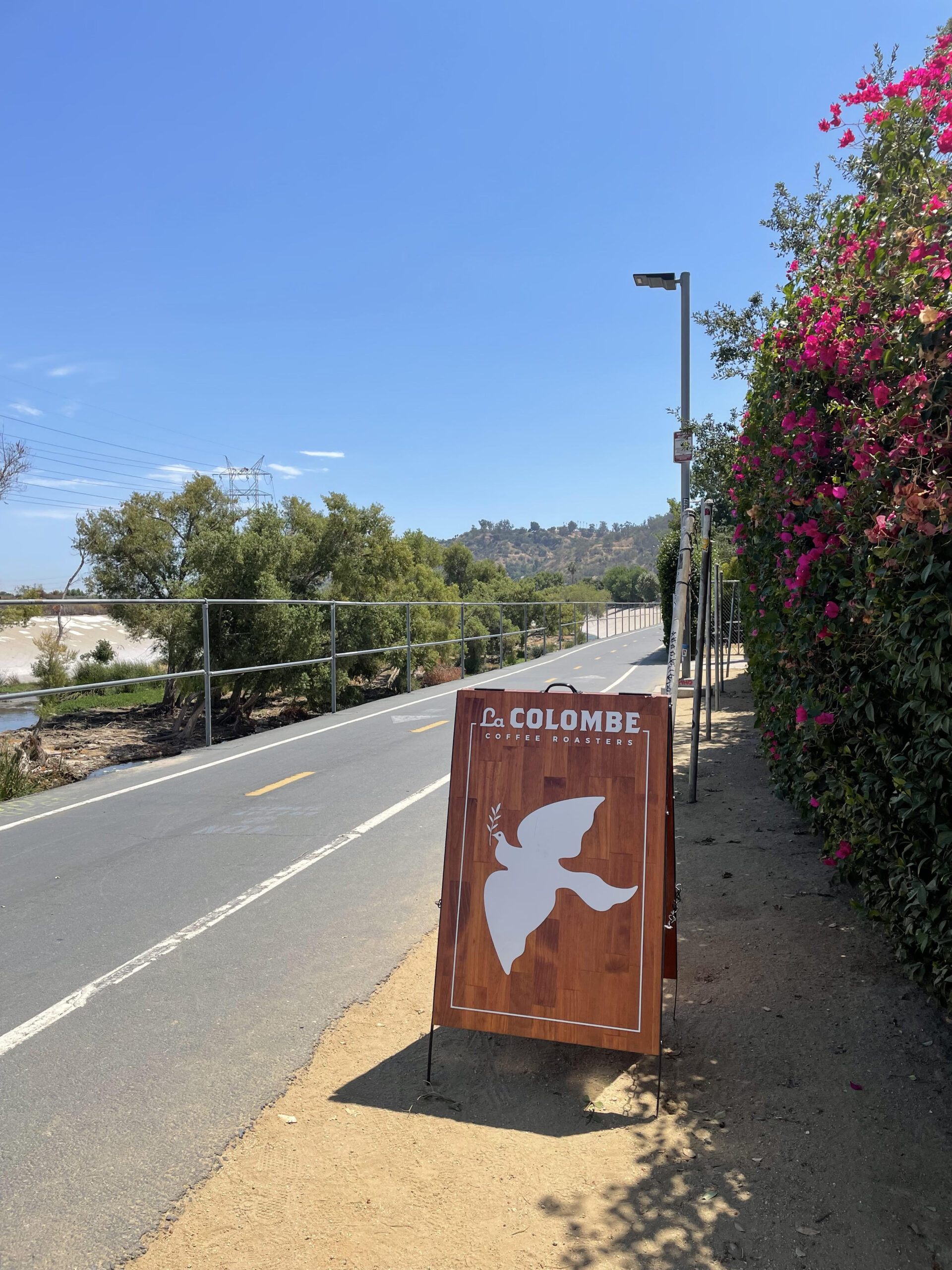
~End of interview~
For updates about classes, workshops, events and studio showings, remember to check their Instagram!
Studio Melt Instagram @studiomelt_la
Amanda’s IG @claypants
Ethan’s IG @ethanmstern
